
Your guide to plan ultimate Bali itinerary for 1 to 2 week

It was hard to believe our eyes when we saw the secluded beach below us. The water was a dazzling shade of blue, sparkling in the sun. The sand appeared white and smooth, untouched by trash or seaweed. The cliffs rose majestically around the beach, creating a natural amphitheater. How could such a gorgeous place be so empty? We expected to see hordes of tourists and locals, but there were only a few scattered souls. Curious and excited, we headed for the stairs that would take us down to paradise. But soon we discovered the reason for the solitude.
We found ourselves at a point that had no fence whatsoever to help us get down to the beach. The section where we stood sloped down a few meters onto a rocky edge. A rope tied to a nearby tree was the only hope to support our climbing down through a rock-strewn track. Gloriya by then was seeming perturbed about the idea of coming here yet she was unwilling to give up or return. It would be a failure if we came so close to the beach and missed it. A few courageous teens who were behind us smilingly held onto the rope and went down in no time. We looked at each other and asked ‘It can’t be that difficult, isn’t it?’ So, first I tightly held onto the rope, kept one of my feet carefully on a rock, and started to climb down. She followed me and shortly thereafter we saw a bamboo ladder touching down to the beach sand below. We both managed to safely reach the T-REX beach or Kelingking beach. The insane view that we were rewarded with indeed made all the efforts worthwhile. As the crashing waves hit our feet and shifted the sand beneath, we looked at the mighty cliffs around to realize ‘this is what makes Bali an unforgettable experience’.
In our two weeks of exploring, we came across different faces of Bali. From running wildly at the sleepy rice terraces to strolling at busy stretches of popular beaches, from shopping collectibles in crowded shopping alleys to dancing to the tunes of DJs at extravagant beach parties, from witnessing the charm of quaint cottages in paddy fields to soaking into the luxurious jacuzzi in a fancy resort, from discovering waterfalls hidden behind canopies to feeling blessed at ancient temples on the cliffside. No matter which side of Bali you want to see, it will offer truly unmissable experiences during your trip.
Bali is a quintessential tropical paradise. It’s a memory that forever etches in your mind, an emotion that lingers in your heart for infinity. It’s the kind of place that echoes ‘Life is Beautiful’. Bali is so much more than a place, it’s magical. For us, Bali is a therapy that can heal any woes.
Table of Contents
While a month may fall short for exploring a place that has so much to offer, we believe 10 to 14 days is a good amount of time to explore the best of the “Island of Gods”. We realized that for a destination like Bali, an itinerary can be planned for a different number of trip days.
If you’re aiming to explore Bali’s major highlights, a week should suffice. For a more comprehensive experience encompassing the island’s beaches, waterfalls, temples, cuisine, activities, and off-the-beaten-path spots, two weeks are ideal, just like our own journey. However, if your itinerary extends to covering all corners of Bali and its neighboring islands, allocate three to four weeks to avoid feeling rushed. You might be wondering how to fill so many days in one place. Let me assure you, that in Bali, the potential for encountering magical moments is boundless.
Our itinerary included leisure days for basking in the sun, sand, and sea, alongside days dedicated to exploring various parts of the island.
Uluwatu: 2 nights
Uluwatu holds a special place in the hearts of many, and we wholeheartedly share that sentiment. Perched on a cliff’s edge, it offers a breathtaking panorama as the sun gracefully sets into the vast expanse of blue waters. The symphony of crashing waves against the rocks below, the delicate scent of incense wafting from nearby temples, and the gentle caress of the evening breeze against our skin create an unforgettable atmosphere. This is how we wish to etch Uluwatu into our memories.
With its proximity to the airport and revered temple, choosing Uluwatu for our initial two nights was an obvious decision.
Arriving at the hotel in the late afternoon, we wasted no time and quickly dropped off our luggage in our room. Our taxi driver, who had transported us from the airport, kindly offered to take us to the temple for an additional 25000 IDR. Upon reaching the temple, to our surprise, he accompanied us inside and assisted us in obtaining tickets from the counter. Not only did he help us don sarongs (unisex clothing – an unstitched piece of cloth to wrap around the waist and secured with a knot), but he also graciously gifted me a traditional udeng (traditional headdress worn by Balinese men). This was the first time we felt the warmth of Balinese hospitality. Guiding us through the main complex, he pointed out key areas of interest and even arranged tickets for the Kecak Performance. Expressing our gratitude for his generosity, we began to explore the complex.

Day 1: Arrival, Uluwatu Temple (Pura Luhur Uluwatu) & Kecak Dance:
Built on the edge of a cliff overlooking the Indian Ocean, and landscaped with beautiful gardens, the temple has a serene vibe to it. Being one of the nine directional temples, the Uluwatu temple has a lot of cultural & spiritual significance to Balinese Hindus. The temple hosts many ceremonies and festivals throughout the year. But for visitors what evokes interest is ‘Kecak Dance Drama’. Originally a trance ritual to cast off evil spirits, Kecak was adapted into a Dance Drama in the 1930s by Walter Spies (German painter and musicologist) in collaboration with Indonesian dancer Wayan Limbak.
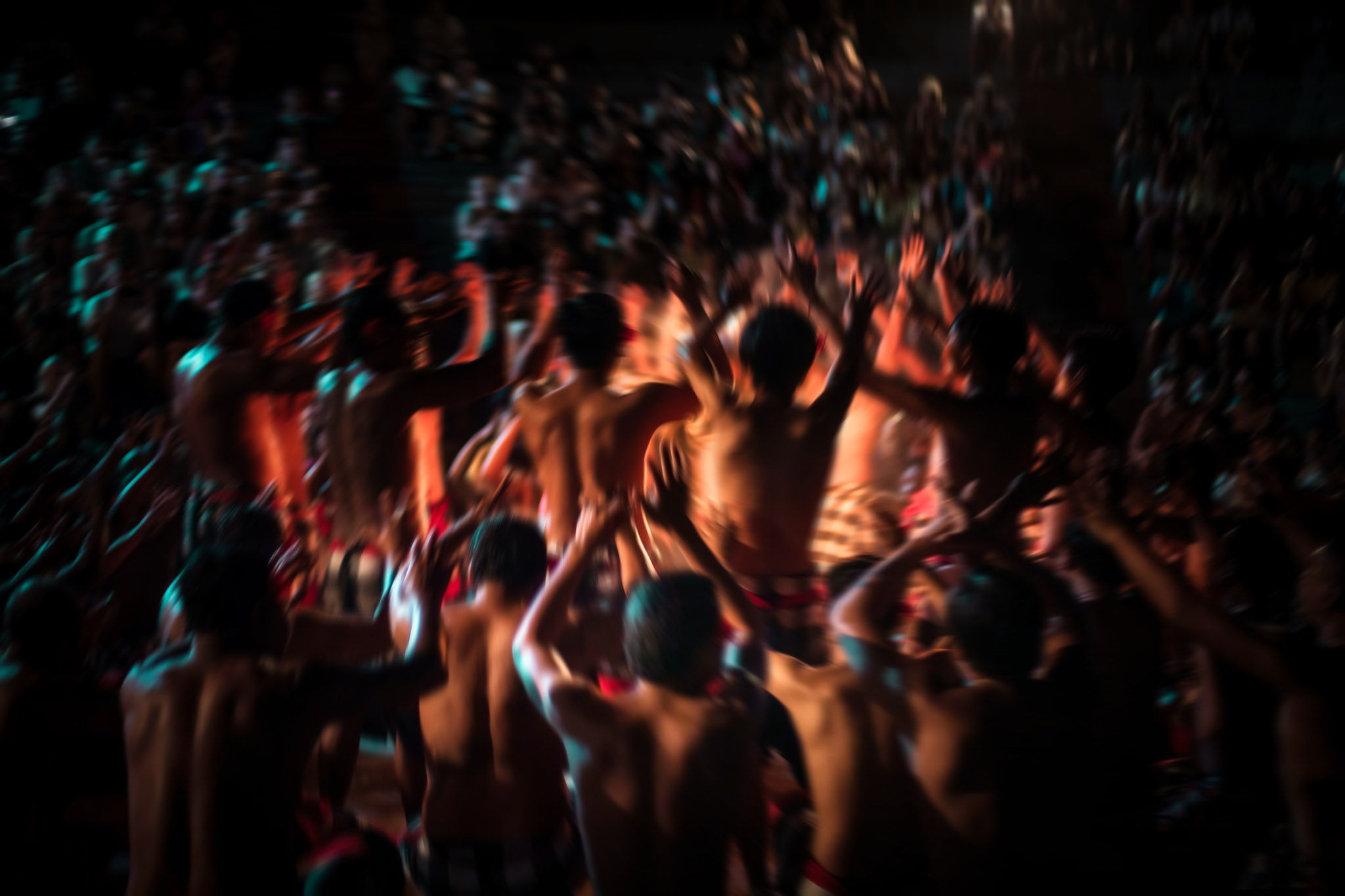
In this performance, a group of men sitting in a circle in an open-air amphitheater chants the “chak-kechak-kechak” sound in a synchronized rhythm while swaying their bodies and waving their hands in unison. In the center, a few male and female dancers in their Balinese attire enact pieces and fragments from the ancient Indian epic ‘Ramayana’. The dancers mainly play the characters of Lord Rama, Sita, Lakshmana, Hanuman, Sugreeva, the Golden Dear, and King Ravana.
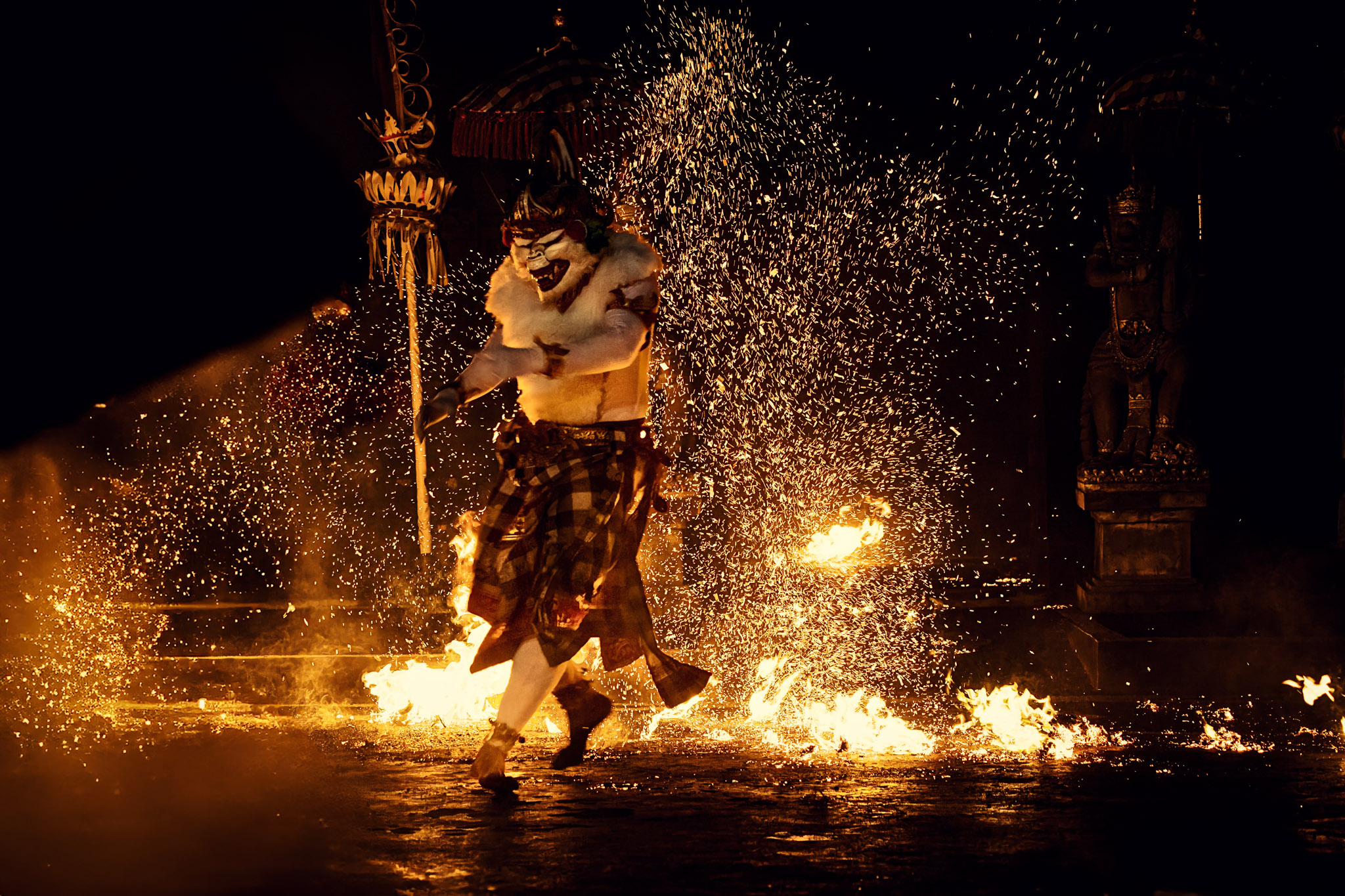
There are no other background instruments used yet the performer’s expressions and movements, the coordinated chanting, elaborated costumes and headgear, interaction with the spectators, and the use of fire and theatrics towards the finale make it an unforgettable and unmissable cultural performance.
The whole performance lasts for 60 minutes. Two shows happen at 6 and 7 pm. Although the amphitheater is quite big, sometimes tickets may get sold quickly if there are more visitors. Try to reach at least before 5 PM to observe the sunset and explore the full temple before ending the day with a Kecak dance.
Note: As a means of respect to the culture, dress modestly covering your shoulders and knees when entering the temple. Otherwise, you would need to wear a sarong and a shawl which are available for free near the ticket counter.
There are no restrictions on clicking photographs of the performance but be sensible of the performers and the audience. Try not to use any flash and avoid getting in the way of the dancers as they move around the whole platform.
Caution: One thing that you have to be alert about is the monkeys living in the temple and surrounding forest. Although the monkeys are considered sacred in Balinese culture, the ones in Uluwatu are quite mischievous and often snatch belongings from visitors. Avoid holding cameras, purses, sunglasses, fruits, food items, or anything in hand that might attract the monkeys. It’s better if you do not wear flip-flops or be careful. We witnessed a distressing incident where a monkey attempted to steal a woman’s sandals right off her feet simply because they featured an image resembling a fruit. Her frightened child started to cry. Luckily a temple guard intervened and shooed the monkey away with a slingshot.
By the time the kecak performance was over it was already past 8 in the evening. We were too tired from the journey, so we finished our dinner at a cafe near the temple and returned to the hotel.
Opening Hours: 7 am – 7 pm
Entrance Fee: 50000 IDR
Kecak Dance ticket: 150000 IDR

Day 2: GWK Cultural Park and Nyang Nyang Beach
Garuda Wisnu Kencana (GWK)
Our second day started with a visit to Indonesia’s tallest statue Garuda Wisnu Kencana, a 120-meter-high monument that stands as an prominent tourist attraction at Ungsan in Badung Regency. The idea of the statue was conceptualized based on the story of the Hindu God Vishnu riding on his winged mount (Vahana – a divine creature/animal) Garuda (a demigod considered to be the king of birds in Hindu mythology) in search for Amrita or Elixir and designed by Indonesia’s finest sculptor Nyoman Nuarta.

The 60-hectare park itself was built to host art & cultural events, exhibitions, international concerts & shows. Besides the central statue, there are several other sculptures, gardens, a museum, a photo studio showing the essentials of Balinese heritage and lifestyle, and an amphitheater for dance and cultural performances. A unique Kecak Dance also happens here that was specifically designed for GWK.
Visitors can enjoy various facilities, including shops offering distinctive Balinese crafts and souvenirs, restaurants serving delicious cuisine with views, and a Buggy service for convenient transportation.
Opening Hours: 8 am – 10 pm
Tickets start from 125000 IDR (if not opted for the shuttle)
Buggy Shuttle Service: 40000 IDR
Nyang Nyang Beach:
Nyang Nyang Beach is tucked away beneath a towering cliff and is one of the lesser-visited beaches along the Uluwatu coastline. Its seclusion means you’ll need to hike down from the main parking area above, but it also offers an undisturbed and peaceful experience. The beach is known for its clear waters, and golden sands, and is a favorite spot for surfers and paragliders. There’s even a shipwreck nearby, perfect for some great photo opportunities. If you’re interested in quirky accommodations, the famous Bubble Hotel has set up a bubble campsite right on the beach. Additionally, the owner of the Bubble Hotel has transformed a Boeing plane into an ultra-luxurious hotel atop a cliff, which recently opened. We were fortunate enough to visit the plane during its construction phase.
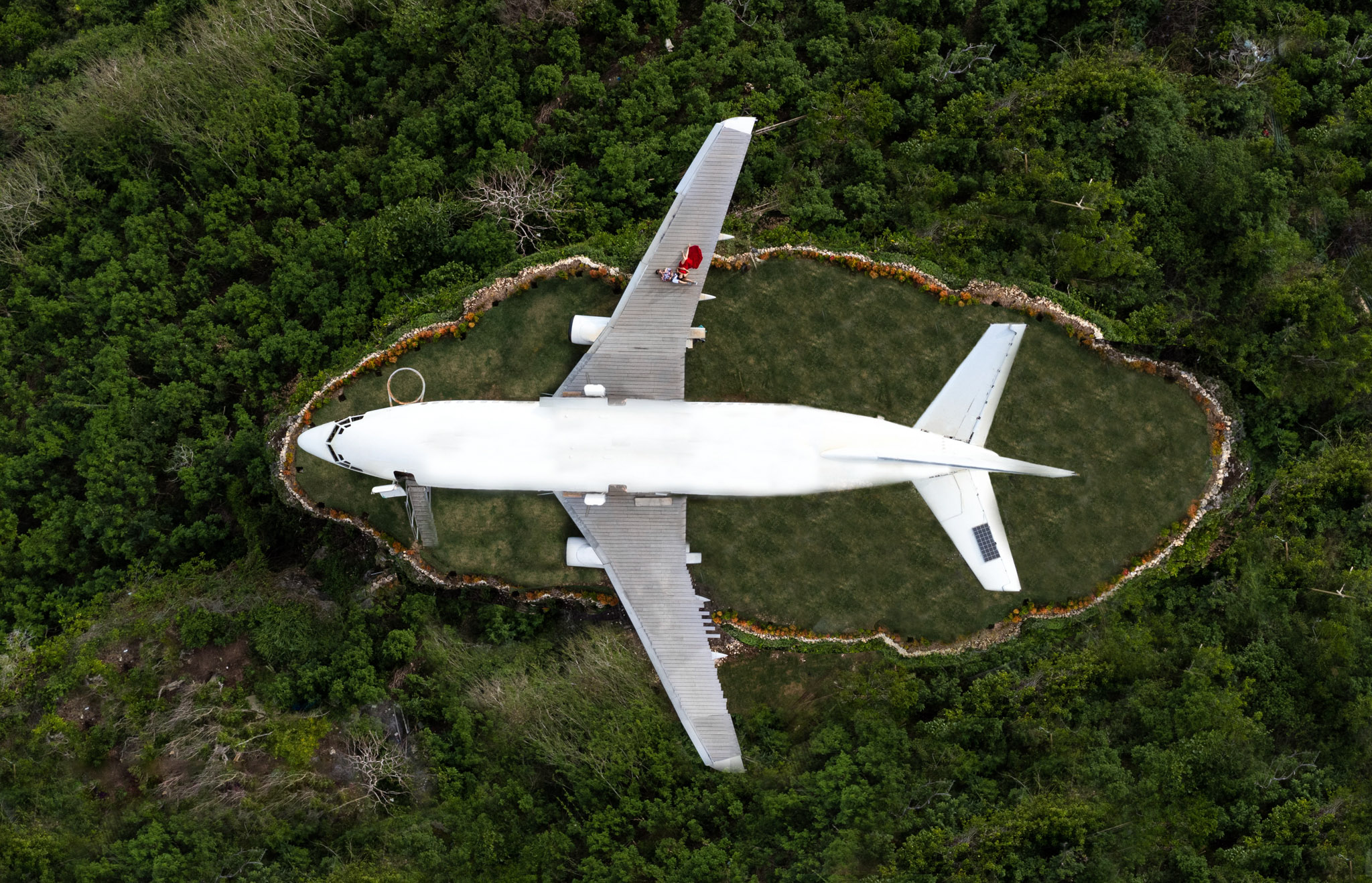
From Nyang Nyang Bali restaurant there is a paved way that leads to the beach. There is no specific entrance fee to visit the beach but it operates on a donation basis. Something like 5000 IDR is good enough.
The beach was a walkable distance from our accommodation however if you are visiting from far then keep in mind that app cabs and taxi services only drop near the parking area, and there is no pick-up or waiting allowed. If you wish to return you can take the locals offering bike taxis.
Nusa Penida Island: 3 nights
The Nusa Islands are a cluster of three islands (Nusa Ceningan, Nusa Lembongan, and Nusa Penida) just off the coast of Bali. While Bali’s popularity continues to soar, drawing throngs of tourists each year, the Nusa Islands retain a sense of untouched beauty reminiscent of decades past. While many visitors opt for brief day trips, we urge you not to miss the opportunity to immerse yourself in the rustic charm and mystery of these islands by staying a little longer.
Nusa Ceningan is the smallest of all and lies between the other two. Nusa Lembongan is the closest to the main territory and serves as a base for those who want to explore all three islands, most known for snorkeling, diving, mangroves, tidal pools, and clean beaches. Nusa Penida is the biggest and slowly gaining more prominence among tourists in terms of day trips.
Instead of traveling to all three, we decided to only cover Nusa Penida mainly because we wanted it to be less hectic and at the same time view many of its untouched cliffs, unique rock formations, astounding bays, and nature trails. We are glad to have included Nusa Penida in the itinerary, it was indeed a paradise away from the bustling life of Bali.
How to reach and get around the island:
There are many ferries and fast boats that leave multiple times a day from Sanur. We took the 7:00 am boat and the journey took about 30-40 minutes. There is an entrance/tourist fee of 25000 IDR per person that is collected for the betterment of the island infrastructure.
The island is quite big and hiring a scooter or a car with a private driver is required. After getting down at the Banjar Nyuh port, we spoke to one of the taxi drivers and convinced him to take us to the hotel first for check-in formalities and then a full-day trip around the island. We paid him 500000 IDR. A moped/scooter costs a bit more here than in Bali, prices start from around 80000 IDR and can go up to 200000 IDR for a day depending on the model.
If you plan a day trip then it is recommended to take the earliest boat so that you can visit most of the places before returning to Bali.
We pre-booked our tickets in Angel Billabong boat through 12go.asia
https://12go.asia/en/travel/bali/nusa-penida
The cost of a one-way transfer was 320000 IDR (1700 INR) for two.
Day 3: Angel Billabong, Broken Beach, and Kelingking Beach
Angel Billabong
 Angel Billabong is a naturally formed tidal pool between beautiful rock formations with the backdrop of blue waters, making it a good spot for leisurely swim and dip. If you are planning to get down to the pool then make sure to arrive during the low tide hours, as the high tides often crash with extreme power and can easily wash out anyone (even the best of the swimmers) to the open ocean. Avoid swimming close to the edge of the pool and come out if you notice any signs of unexpected waves, it may occur any time of the day. We reached there a little before noon and saw two girls swimming down there in seemingly calm waters. But a sudden and strong wave pushed them to the rocks, luckily both came out immediately and were unharmed.
Angel Billabong is a naturally formed tidal pool between beautiful rock formations with the backdrop of blue waters, making it a good spot for leisurely swim and dip. If you are planning to get down to the pool then make sure to arrive during the low tide hours, as the high tides often crash with extreme power and can easily wash out anyone (even the best of the swimmers) to the open ocean. Avoid swimming close to the edge of the pool and come out if you notice any signs of unexpected waves, it may occur any time of the day. We reached there a little before noon and saw two girls swimming down there in seemingly calm waters. But a sudden and strong wave pushed them to the rocks, luckily both came out immediately and were unharmed.

Broken Beach
Just a short stroll from Angel Billabong lies another stunning destination and a popular island attraction known as Broken Beach, locally referred to as Pantai Pasih Uug. This famous beach got its name from the natural archway bridge, formed due to millions of years of erosion of the limestone cliffs and sea abrasion, creating a circular cove around the bay. Although there is no access to the actual beach itself the dramatic view of the cove surrounded by vertical cliffs, makes it a panoramic spot for photography. The main vantage point where the cove and the archway are visible against the bay, is always busy with many tourists and their guides trying their best to get the perfect frame. However, in and around the area there are plenty of other sites that are picture-perfect. So don’t wait in queues. We spent an hour there and it was good enough to click some nice shots as well as admire the wonder and beauty of Mother Nature. There are few shops available along the stretch selling coconuts, water, snacks, souvenirs, etc.
We read there was an entrance fee of 5000 IDR for Angel Billabong and Broken Beach but we were not charged any. There is a parking charge though.
T-Rex/ Kelingking Beach
This famed beach tops the list of must-visit places in Nusa Penida for a reason. The overwhelming landscape accentuated by azure water and white sandy stretches, otherworldly rock formations resembling the head of a Tyrannosaurus rex from the Jurassic age makes it quite famous, so much so that it was voted second best beach of Asia in TripAdvisor Traveller’s Choice Awards 2023.

Most visitors exploring the beach mainly flock to the overlook which is typically 10 minutes walking distance from the parking lot. The descent down from a 400m-high cliff viewpoint to the actual beach is a challenging task and requires a moderate amount of fitness level. For the first 10 to 15 minutes the track has stairs built fenced by wooden railings, which is accessible by many. But as you keep going down the trail starts to get steeper, narrower, and completely rocky, requiring some solid scrambling skills. Further down towards the end, it’s almost like rappelling, holding a rope tightly and carefully making way to the beach. It gets pretty hot during the day and you are bound to get tired. So, carry enough water and wear good trekking shoes. We left our water bottle in the car and regretted it while trekking down. Luckily after reaching the bottom of the cliff, we found locals selling water, beers, and coconuts, we could not be happier.
Those of you who accomplish the hard trail will enjoy the magnificent view of the bay with very few visitors sunbathing or swimming. Almost gives the feel of a private beach. The water looked choppy and wouldn’t recommend anyone swimming far from the shore. We were comfortable just to have sat there dipping our feet in the water.
It is certainly not recommended for casual walkers, those with low fitness or fear of heights. But if you still wish to enjoy a good view without going down all the way or having to compensate for standing amongst a large crowd then walk just half the way until the end of the concrete stairs and have an exhilarating sight of the ocean and the limestone cliffs.
You should allow at least 45 to 60 minutes to navigate down and similar or more time to reach the starting point. Surprisingly we took less time to climb up.
Day 4: Diamond Beach, Ruma Pohon & Thousand Island Viewpoint
We had planned to visit Diamond Beach early in the morning but all our plans got changed as we ended up partying crazy with a few fellow travelers and the owner of the accommodation the previous night. More about that story in our next blog about our Bali stays.

Diamond Beach
Another hidden beach of Nusa Penida that looks postcard perfect. Epic diamond-shaped limestone rocks appearing out of the shallow velvety blue water, shiny white sand, and stairways carved out of cliffs turn this beach into one of the most beautiful beaches that we ever visited. It is located on the east coast of the island and is close to other famous attractions like Atuh Beach and Thousand Island Viewpoint.
The beach was beyond reach up until the end of 2018. Since then, local developers carved a stairway into the cliffside, opening up this marvelous beach to the public. Now you not only can enjoy the vivid sight of the beach from atop but can get down to the bottom through the stone stairs. Though most of the winding stairway is somewhat protected by wood and rope fences, the last 5-meter section of the vertical cliff has minimal footholds. Just like the kelingking beach, there is a rope to hold onto while you carefully rappel down.
Once you make your way to the beach, this hidden piece of paradise with its unmatched beauty would make it hard to resist getting into the water. But beware this beach is not meant for swimming, even for the seasoned swimmers. Dangerous rip tides containing a lot of coral and rocks make the waves rough & unpredictable. There were many incidents of people struggling to get out of the water or being drowned even from waist-deep water. So don’t take any risks and stay away from the waters. Rather enjoy the surreal view, click photos, and create beautiful memories.
Visiting the beach would take an hour to two depending on how long you want to spend down there. It takes about 20 minutes to climb down the stairs. The entrance fee is 10000 IDR.

Ruma Pohon Treehouse & Thousand Island Viewpoint
Have you ever dreamed of living in a treehouse? Imagine waking up to the sound of birds and the sight of the sea and rocks. Imagine being one with the nature and away from the the city.
Treehouses are not just a fantasy. They are a reality for many people around the world. Treehouses have a long history, dating back to prehistoric times when people built platforms or nests in trees to protect themselves from predators and other dangers on the ground. Today, treehouses have evolved into more than just shelters. They are places for recreation, leisure, and even living.
One of the most amazing treehouses in the world is located on Nusa Penida Island, Indonesia. It is called Rumah Pohon, which means Tree House in Indonesian. Rumah Pohon is not just one treehouse, but a cluster of three wooden huts on a hill overlooking the ocean. The view from Rumah Pohon is wonderfull. You can see the crystal-clear water, the white sand beach, and the iconic rock formation known as Thousand Islands.
Rumah Pohon has emerged as a favored spot among travelers seeking different and adventurous experiences. It has also become a hotspot for Instagram enthusiasts looking to capture and share the expansive terrain with their followers. Rumah Pohon is not a luxury resort, but a simple and rustic accommodation that offers basic amenities and facilities. You have to climb a small ladder to reach your hut and share a bathroom with other guests. But the trade-off is worth it because you get to enjoy the beauty and tranquillity of nature like never before.
When we visited it was late afternoon the conditions were good for photos with clear blue skies, vibrant ocean, and illuminated by the sun partially hiding behind the cliffs. After paying a fee of 75000 IDR (which is not an entrance fee but paid for a photo opportunity at the treehouse) you need to walk down a rocky terrain with about 150 steep and uneven steps to reach the tree house. While leading down the path you will observe other photo spots like Coco Cliff: 50,000 IDR per person, Swing: 50,000 IDR per person. We were not interested in those as you can find such spots all across Bali, some for free. There is a shaky wooden staircase and a rope handle that helps the visitors to enter the tree house. When we visited no guests were staying but be aware of the space if you see some guests staying there overnight.
Our driver told us that during peak seasons and daytime, there are a lot of crowds queuing up to take photos at the treehouse. At times even 30 minutes of waiting is required and at the end, you get only a few minutes to click. We were lucky that when we visited there was hardly anyone other than a couple of boys who gave us ample time to enjoy the view and take photos. They even helped us with a few captures.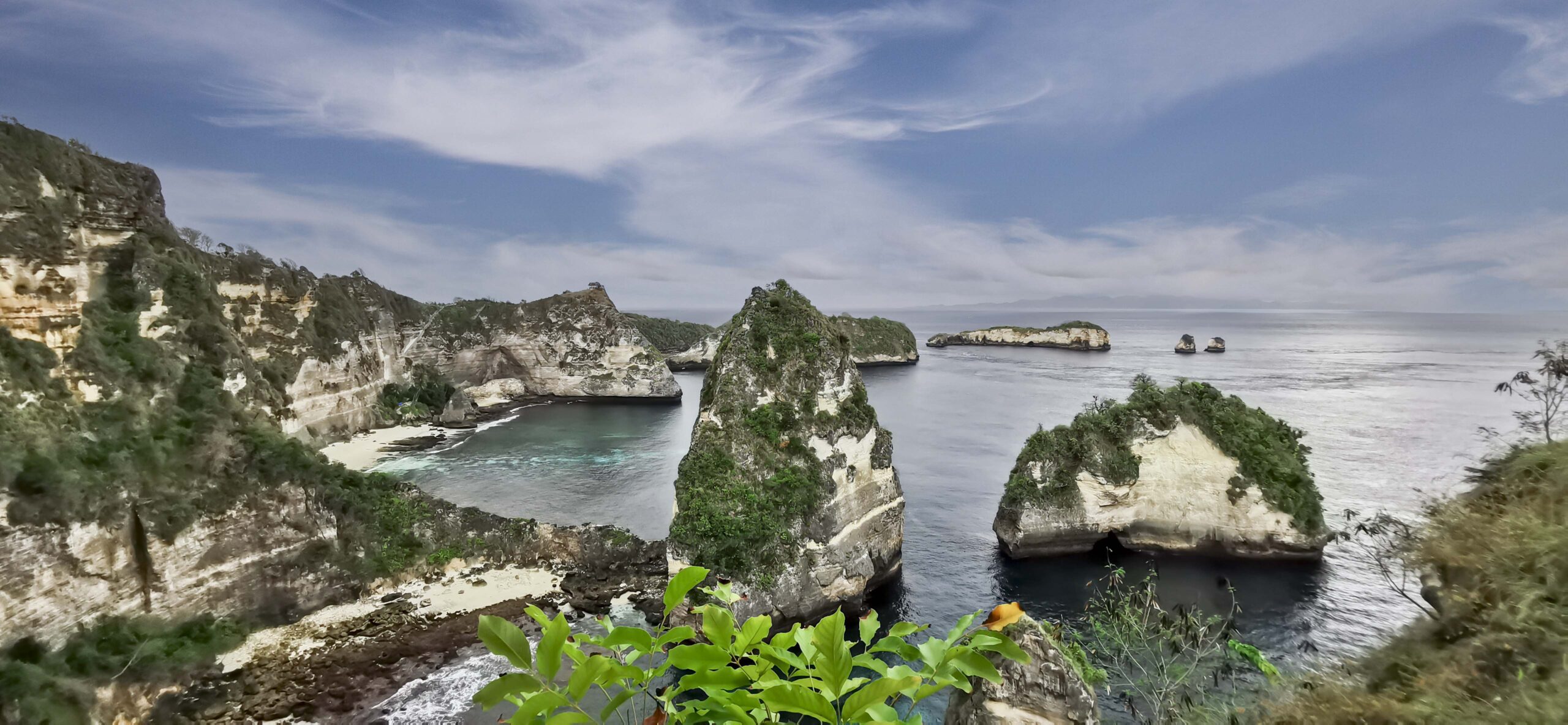
Once you are done head over to another viewpoint right next to the treehouse known as Thousand Island Viewpoint, an isolated hilltop that offers a panoramic view of the sea, smaller islands, and the rocks.
By the time we started to go back to the parking area, it started to drizzle. We were a bit thirsty from all the stairs climbing. We bought some tender coconut from the on-site warung and relished the cool coconut water at the end of a memorable day.
Day 5: Snorkel & Manta Dive
Have you ever been wonderstruck seeing this sea creature called ‘Manta Ray’ that glides through the ocean like a flying carpet? We spotted Mantas for the first time in Maldives from our over-water villa. Seeing two Mantas gliding gracefully by flapping their wing-like fins, we were at a loss for words. Early in the morning as they swam in shallow water, the sunlight reflected on their skin and created a dazzling contrast with the blue sea. When we learned that there are Snorkeling and Manta Dive tours available in Nusa Penida, we knew we had to do it. Since we had not pre-booked any tours our Guesthouse owner helped us to book a tour that would cover snorkeling with Manta Rays. The owner was even generous enough to Drop and Pick us up from the Activity center.
The Manta rays are usually seen all year round, but April to October is a good time to see them. They tend to be more active in the morning, so try to book an early tour if possible. The snorkeling spots are also less crowded in the morning, which means you can enjoy the underwater scenery more quietly as you snorkel.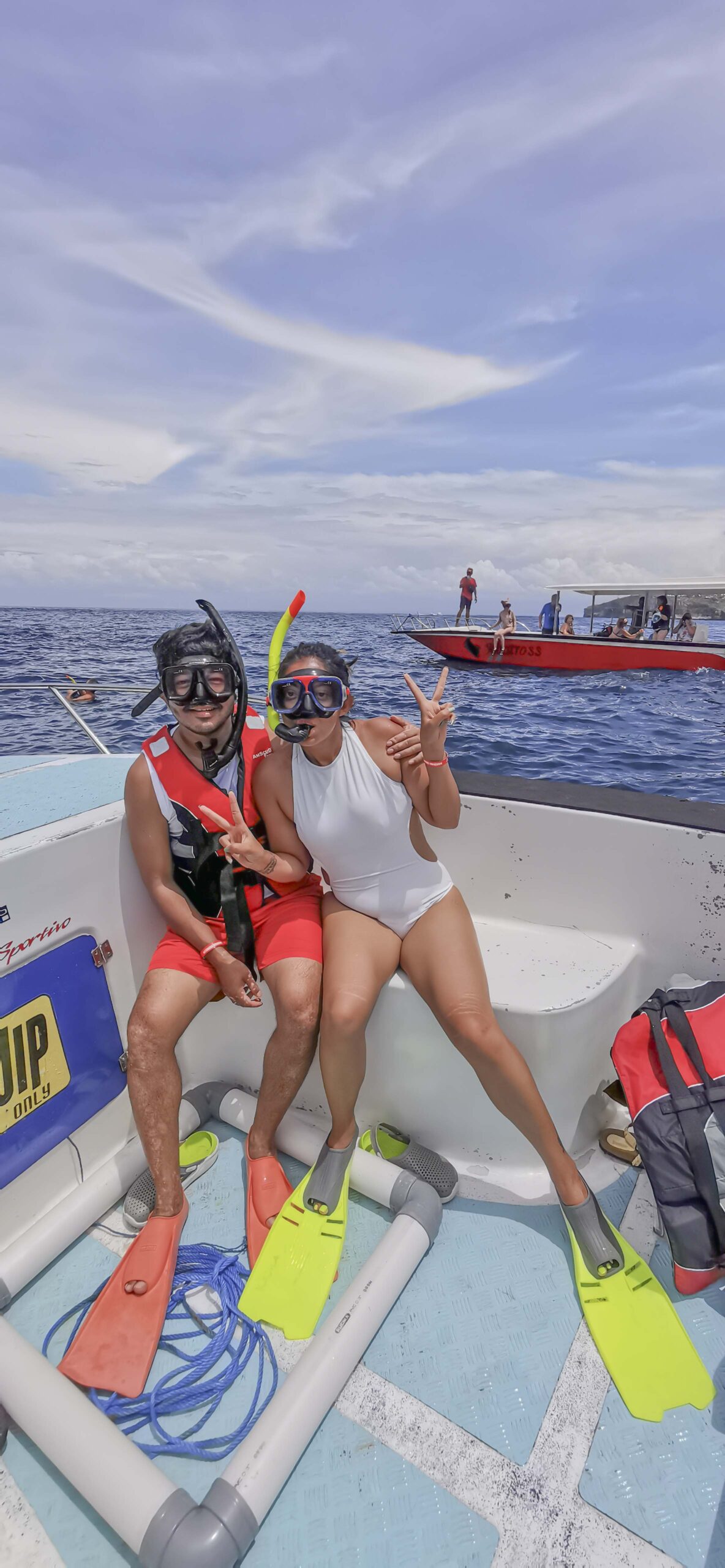
Since we were already in Nusa Penida, we booked a 3-hour tour and it cost us 250000 IDR (1300 INR) per person. Based on the weather and water clarity you will be taken to several snorkeling spots, such as Crystal Bay, Gamat Bay, Manta Point, and Wall Point. Each spot has its charm and features different types of corals and fishes.
The highlight of the tour is Manta Point, where you have a chance to see the giant manta rays up close. These gentle giants can grow up to 7 meters in wingspan and weigh up to 2 tons. They are harmless to humans and feed on plankton. They often swim near the surface of the water, making them easy to spot and observe. However, they are also shy and sensitive to noise and movement, so you need to be mindful and respectful when snorkeling with them.
Unfortunately, we were not lucky enough to see any manta rays on the day we visited. Our guide told us that it was a rare occurrence and that sometimes they just didn’t show up. We were disappointed, but we understood that it was part of nature and that we couldn’t control it. We still enjoyed the snorkeling experience and saw many other colorful fishes like clownfish, angelfishes, butterflyfishes, parrotfish, triggerfishes, and more.
If you are looking for an adventurous and memorable activity in Bali, you might want to consider doing a snorkeling and manta ray tour on Nusa Penida Island. Just remember to book in advance, choose a reliable operator, go early in the morning to avoid the scorching Sun, be respectful of the environment and the creatures, and have fun!
After the snorkel tour, we finished our lunch and headed to a different boutique hotel on the east side of the island. We did not have any further plans for the day, so we just relaxed. The evening was a blissful mix of cocktails, music, and ocean breeze. We savored every moment as a local band serenaded us with their skills and tunes.
The next morning, we returned from Nusa Penida to spend the next few days in Bali’s vibrant town Ubud.
Ubud: 4 nights
Ubud is a town in Gianyar Regency which is the central part of the island, surrounded by rice terraces, forests, and temples. What sets Ubud apart is its multifaceted allure, appealing to a wide range of interests and tastes. Whether you’re drawn to Bali’s rich history and culture, seeking wildlife encounters and adventure, craving relaxation and rejuvenation, or simply eager to savor local cuisine, Ubud offers a myriad of experiences for all.
Day 6: Hidden Canyon, Sacred Monkey Forest, Tegenungan Waterfall
Hidden Canyon Beji Guwang
Our day started with a visit to a secret canyon located in the village of Beji Guwang, about a 30-minute drive from Ubud. Although the name Hidden Canyon might give the impression of it being some deserted place amongst the jungle, the fact is it has a ticketed entrance. The fee is 120,000 IDR for a single person, but it gets cheaper if you go in a group. The ticket price includes a guide charge, water bottle, changing room, bath towel, and locker.
The Canyon is a series of deep gorges carved by the Oos River over thousands of years. The mid-rise canyon walls are made of eroded rocks of different shapes, sizes, and patterns, creating a splendid scenery. The water level and current vary at different sections, depending on the season and the rainfall. But be prepared to get soaked, struggle through chest-deep water, swim, climb, and jump through the canyon. Until we reached halfway across the canyon, we had no idea how challenging it could be. This is the reason you must take a guide with you, as the canyon can be dangerous and arduous without one. The experienced guides are locals who know every inch of the canyon well and will help you navigate through it safely.
Our guide Katut kept all our camera gear safely in his waterproof bag throughout the slippery terrain. He carefully instructed us on where to step and what to grab to pass from one end to the other. If it was not for him, we would have never dared to complete it. We came across another group of boys who were scared to jump on a submerged rock to pass to the other end of the stream. One of them lost balance while crossing and almost drowned in the ravine. Luckily their skilled and strong guide pulled him out of the water.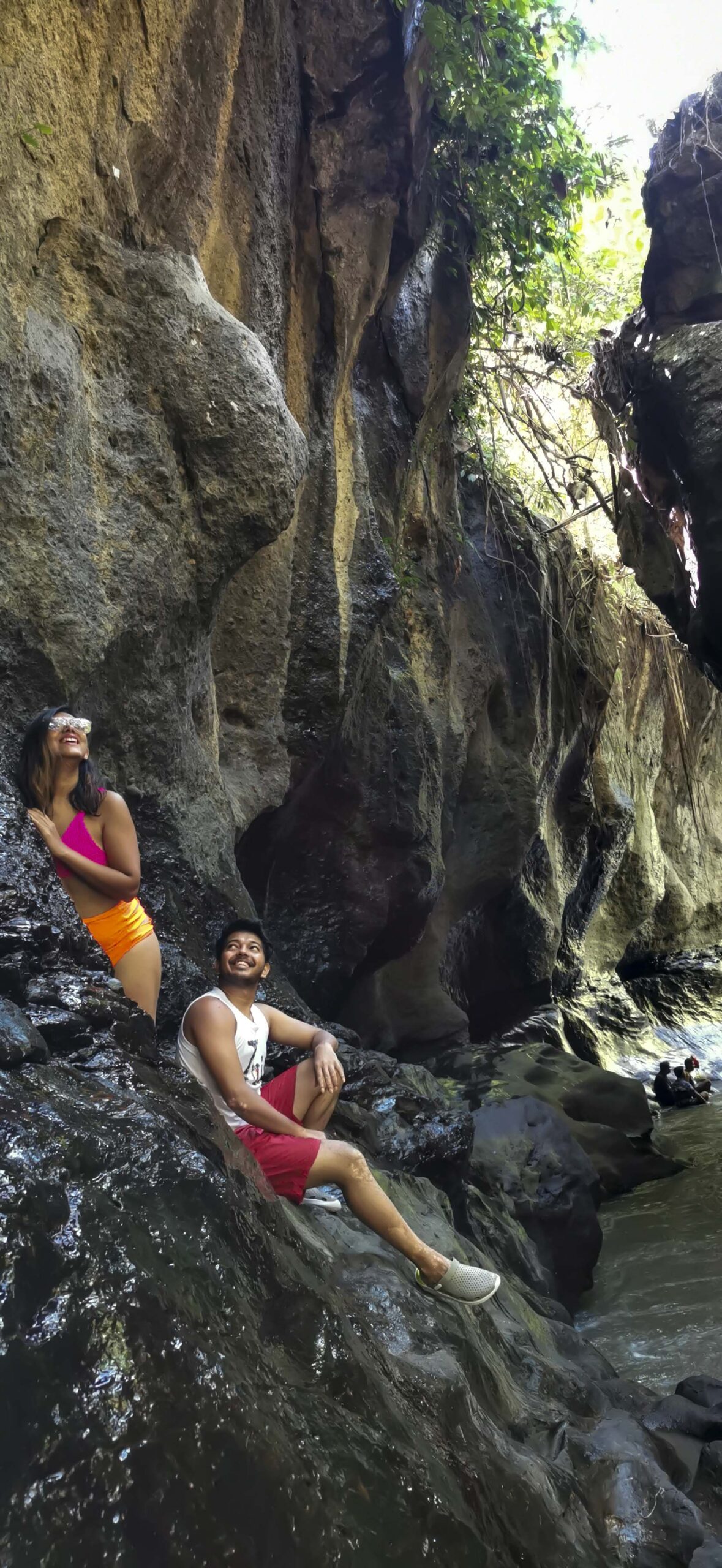
The canyon adventure takes about 2-3 hours, depending on your pace and the water level. It’s recommended to wear comfortable clothes that can get wet, and shoes that have good grip and protection for your feet. You will also need to bring a waterproof bag or case for your valuables, as you will get wet for sure.
The best time to visit the Canyon is the dry season, between April to September. The water level will be lower and clearer, making it easier and more enjoyable to explore the canyon. However, you can still visit during the rainy season, as long as there is no heavy rain or flooding.
The Beji Guwang Canyon is not only a natural attraction, but also a sacred site for the Balinese people. The name Beji Guwang means “holy spring” in Balinese, and there is a temple near the entrance of the canyon where locals come to pray and make offerings. You should respect their culture and beliefs by not littering or making noise in the canyon.
It is a great option to escape the crowds and see a different side of Bali. If you are looking for some new outdoor or adventure-filled nature activity, then you should give it a try!
Ubud Monkey Forest
We reached our next destination the Sacred Monkey Forest of Ubud. Gloriya had already checked it out on her previous trip with her friends, so she stayed in the car to relax. I wondered if she was scared to visit a place filled with Monkeys, especially after what happened at the Uluwatu temple. She said she wasn’t freaked out by the monkeys but I could tell she was lying. She just gave me a grin and pushed me to go explore.
I entered the Sacred Monkey Forest with curiosity. This is a 12.5-hectare natural sanctuary that houses over 1200 long-tailed macaques, who roam freely among the greenery and ancient temples. The monkeys were everywhere, jumping from tree to tree, playing with each other, and looking for food. The monkeys seemed very friendly and curious, and happily posed for photos or even climbed on the shoulders of visitors as long as they offered some sweetcorn or bananas. But be careful, they can also be cheeky and mischievous, and they might snatch your sunglasses, hat, or camera if you’re not paying attention. Although there were guards everywhere.
The Ubud Monkey Forest is more than just a tourist attraction, it’s also a place of spiritual and cultural significance for the Balinese people. The forest is home to three Hindu temples, dating back to the 14th century, where ceremonies and rituals are still performed regularly. The forest is also a conservation and research center, where you can learn more about the monkeys’ behavior, ecology, and health.
The Ubud Monkey Forest is open daily from 9:00 am to 6:00 pm, and the entrance fee is 80,000 or 1,00,000 IDR for adults, and 60,000 or 80,000 IDR for children based on weekdays or weekends. And if you are looking for the famous ‘Monkey selfie’ then you need to buy a separate 50,000 IDR ticket near the selfie booth and the guides there will help you snap one on your phone. You can also hire a guide for an extra fee, who will explain the history and culture of the forest, and help you interact with the monkeys safely and respectfully. The Ubud Monkey Forest is a must-see destination for anyone who loves nature, wildlife, and culture.

Tegenungan / Blangsinga waterfall
After lunch we drove towards the last destination of the day, the Tegenungan waterfall, a scenic spot surrounded by greenery. The waterfall is also known as Blangsinga Waterfall. The name differs depending on which village you come through.
The waterfall was beautiful, with a powerful stream of water crashing down from a height of about 25 meters. We could feel the mist and hear the roar of the water from a distance.
We walked down a series of steps to get closer to the waterfall, admiring the view along the way. There were many people, some swimming in the pool below the waterfall, some posing for photos on the rocks, and some just enjoying the scenery. We decided not to get into the water, as it was crowded and we were tired from the journey. Instead, we found a nice spot to take some reaths of ourselves and the waterfall.
We spent about an hour at the waterfall, soaking in its beauty and energy. There’s an entry fee of 20,000 IDR per person.
Day 7: Campuhan Ridge, Ubud Palace, Ubud Market, Ubud Water Palace & Serayu Pottery
Campuhan Ridge walk
If you are staying in Ubud then one of the best ways to start your day is to take a walk along the Campuhan Ridge, a path that offers calming views of the green hills, rice terraces, and coconut palms. The Campuhan Ridge Walk is a popular attraction for tourists and locals alike, who come here to enjoy the fresh air, the natural beauty, and the cool atmosphere.

The walk starts from the Pura Gunung Lebah temple, where you can see the confluence of two rivers that give the name Campuhan, meaning “where two rivers meet”. From there, you follow a paved road that leads you to the ridge, where you can admire the panoramic scenery of the valley below. The road is mostly flat and easy to walk, with some gentle slopes and curves.
The Campuhan Ridge Walk is about 2 km long, but you can extend your hike by following the signs. The whole hike can take up to 3 hours, depending on how fast you walk and how many stops you make.
The best time to do the Campuhan Ridge Walk is early in the morning when the temperature is cooler and the sun is not too harsh. You will also avoid the crowds and have more chances to take beautiful photos of the landscape. The walk is suitable for all ages and fitness levels, as long as you wear comfortable shoes, bring enough water, and apply sunscreen.
Ubud Palace
The Ubud Palace, also known as Puri Saren Agung, is a historical building complex that was the official residence of the royal family of Ubud. It was built in the early 1800s by King Tjokorda Putu Kandel, who was influenced by Hinduism philosophy and local artistry.
The palace is located in the heart of Ubud, near the famous Ubud Market and the Campuhan River. It has several courtyards, pavilions, and gardens that showcase the traditional Balinese architecture and carvings. You can admire the intricate details and craftsmanship of the palace, as well as learn about the history and culture of the Ubud Kingdom.
The palace is also a center of arts and culture, where you can watch various performances of Balinese dance and music. The most popular show is the Legong & Barong Dance, which is performed every evening at 7:30 pm. The dance is a graceful and elegant expression of Balinese culture, featuring colorful costumes, masks, and live gamelan music.
The Ubud Palace is open to the public from 8 am to 6 pm every day, and admission is free.
Shopping at Ubud market
If you love shopping for authentic items, you will love Ubud Markets located within proximity of the Ubud Palace. These are some of the best places to find local handicrafts, textiles, paintings, jewellery, and more. You can get amazing deals on quality products. Although we did not have any plans for shopping, we spent a couple of hours exploring these markets and were amazed by the variety and creativity of the artisans. There are mainly three markets, all close to each other.
Ubud Street Market is open every day from 9 am to 6 pm. You can find everything from clothes, bags, hats, scarves, masks, handbags, home decor and more. The market is very colorful and lively, with vendors shouting their prices and customers haggling for the best deals. Gloriya bought a beautiful red gown for only 1,25,000 IDR and a couple of Balinese handbags for 60,000 IDR each. We even bought a few T-shirts, and shirts for our family and friends.
Ubud Art Market is more focused on art and culture. It is open every day from 10 am to 5 pm. You can find paintings, sculptures, wood carvings, ceramics, silverware, musical instruments, and more. The market is a great place to discover the rich artistic heritage of Bali and support artists of the neighboring villages. We also had a chance to chat with some of the artists and learn more about their inspirations and techniques.
Ubud Souvenir Market is open every day from 7 am to 7 pm. You can find souvenirs, gifts, snacks, spices, coffee, tea and more. The market is a great place to stock up on some goodies to take home or share with your friends and family.
Shopping in Ubud was one of the most fun and rewarding experiences we had in Bali. We loved finding items in our budget that reflect the culture and beauty of this island. If you are planning to visit Ubud, make sure you allocate some time to explore these markets and enjoy the shopping spree!
Saraswati Temple/Ubud Water Palace
One of the most sacred sights in Ubud is the Saraswati Temple, a tribute to the Hindu goddess of learning, art, and wisdom. This temple is also known as the Ubud Water Palace. The moment you enter the main complex you will come across the serene lotus pond, where pink and white blossoms float on the clear water. The lotus flowers symbolize purity, wisdom, and enlightenment, which are the attributes of Saraswati.
The temple’s ornate doorways are carved with intricate patterns and motifs, inviting visitors to explore the sacred sanctuary. The temple is a place of beauty, stillness, and inspiration, where one can admire the exquisite architecture and feel the divine presence of Saraswati.
The temple is open to visitors every day from 7 am to 5 pm, and you can enter the main temple area for free. However, you need to wear a sarong and a sash, which are available for rent at the entrance. You can also enjoy a traditional dance performance at the temple every evening, which showcases the rich and diverse Balinese culture. The performance is held on the open-air stage overlooking the lotus pond and the main temple. You can buy tickets at the nearby café.

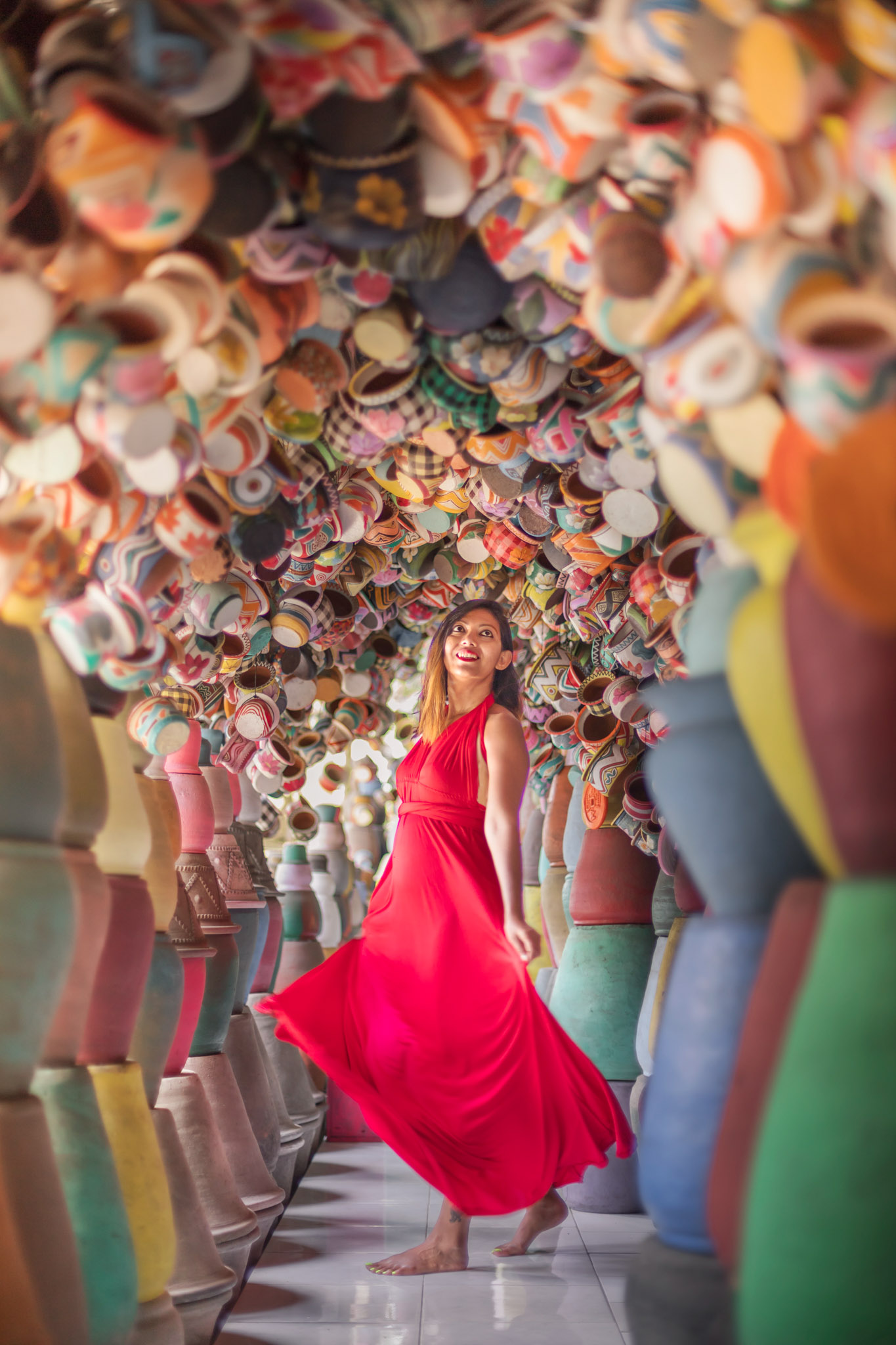
Serayu Pottery
Following our shopping, we ventured to an off-the-beaten-path that doesn’t feature prominently in Bali’s typical tourist destinations – Serayu Pot and Terracotta, a family-run business that showcases the art of ceramic making. We stumbled upon a picture of Serayu pottery in our hotel lobby, and we were captivated by the images of their elaborate designs. Since we were already in Ubud we thought to check this place out.
From Ubud street market the location was not far, so we simply walked as per the Googe maps. Once we reached the location, we were greeted by one of the storekeepers. He was very friendly and welcoming, and he showed us around the store. We saw how they use local clay and natural pigments to make their pottery, and how they shape, carve, and paint each piece by hand.
They organize workshops to teach the visitors how to use a wooden tool to create intricate patterns on the surface of the clay, and how to add details with a brush. You can even try it yourself, and have fun making your designs.
We were amazed by the variety and quality of their pottery. In case you wish to take some pictures then you are expected to pay a small amount of money as a donation. The storekeeper just asked for 14000 IDR which is nearly 75 INR.
Massage at Ipian Villa
If you’re looking for a relaxing and rejuvenating experience in Bali, you can’t go wrong with a Balinese massage. Balinese massage is a traditional form of healing that combines acupressure, reflexology, aromatherapy, and gentle stretching to soothe your body and mind. It’s perfect for relieving stress, tension, pain, and fatigue.
But why settle for a regular massage parlor when you can enjoy a Balinese massage at your private villa by the rice fields? It was late afternoon and we had been roaming since morning. So, we decided to go back to our cozy room that overlooked the lush greenery of the rice paddies. The villa had an in-house masseur who came to our room with a portable massage table, fresh towels, essential oils, and soothing music. We didn’t have to lift a finger or leave our comfort zone.
The best part was that we could enjoy the massage while listening to the sounds of nature outside our window. It felt like stepping into a sanctuary, far removed from the city’s chaos. The ambiance was so soothing that we nearly drifted off during the massage, losing track of time as an hour slipped by unnoticed.
The 1-hour massage was charged 185000 IDR OR 990 INR
If you wish to get a full body massage from a salon then many small salons charge as low as 80000 to 100000 IDR for an hourlong massage, Whereas the upscale places can charge between 300000 to 500000 IDR.
We enjoyed the rest of the evening sitting at the veranda sipping some wine and flying our drone over the paddy fields.
Day 8: Tegalalang rice terrace
Tegalalang rice terrace
Tegalalang Rice Terrace is a valley of green rice fields that are arranged in cascading terraces, following the ancient Balinese irrigation system called Subak. This Rice Terrace is not only a feast for the eyes but also a testament to the harmony between humans and nature. No wonder it is listed as a UNESCO World Heritage site, showcasing the rich cultural and natural heritage of Bali.

You can see how the water flows from one terrace to another, nourishing the rice plants and creating a fertile landscape. The rice terrace is also a popular spot for photography, especially during sunrise and sunset, when the sun’s rays illuminate the fields and create a magical atmosphere. You can also spot some swings and nests just like other popular tourist locations in Bali. We are not a fan of these props as they kind of spoil the whole natural charm. sadly, this also leads to overcrowding with tourists lining up for their turn to take pictures.
The rice terrace is open daily from 7 AM to 6 PM. There is no official entrance fee, but you may be asked to make a small donation of 10k to 20k IDR by the farmers to access their fields. You may need to pay extra for the swings, which vary depending on the height and length.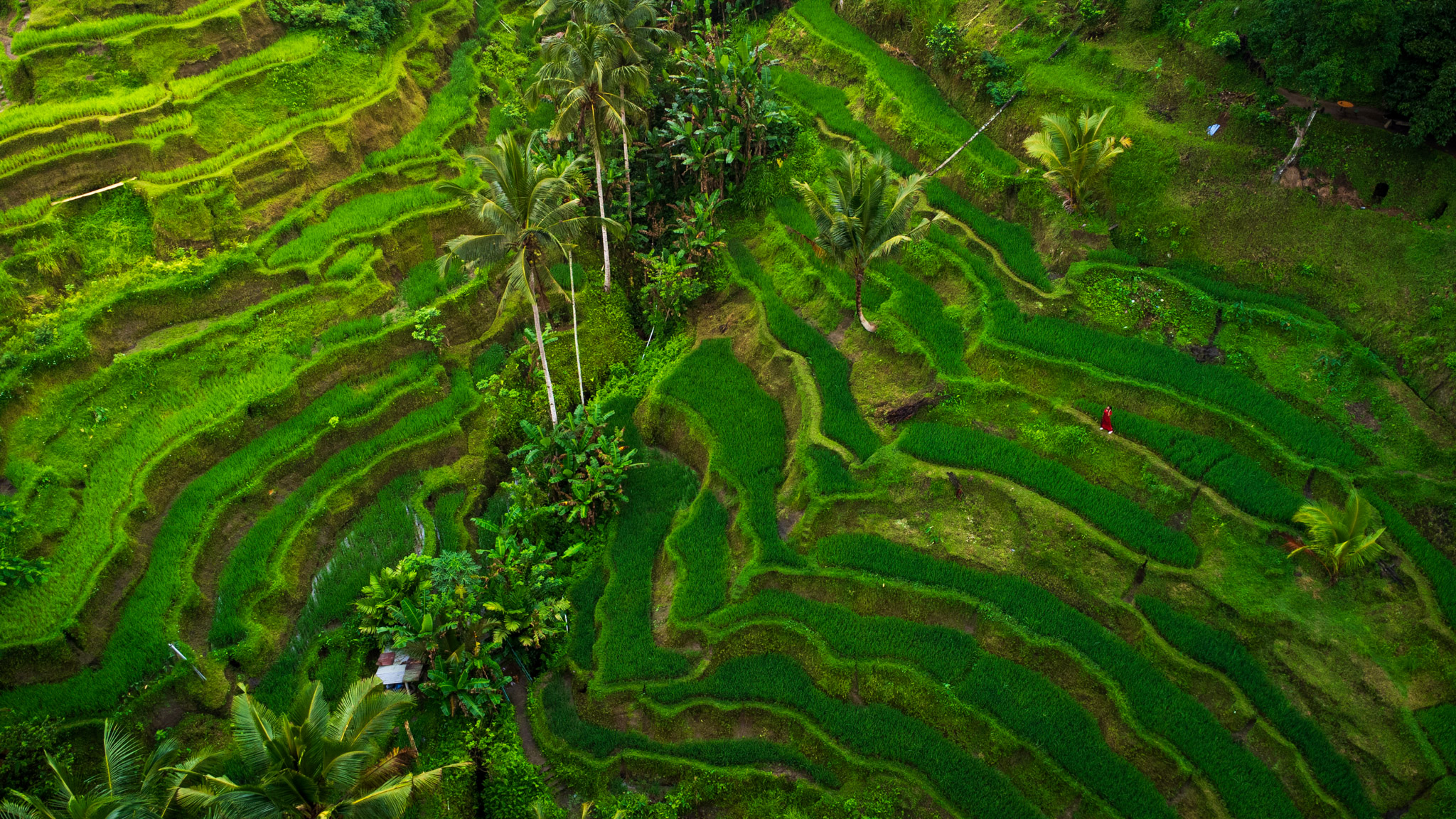
We were so excited to see the terrace garden that we arrived there by 6:30 AM. Our driver pointed us to a gate next to a small café. We descended the stairs through a charming house and met a friendly lady who guided us to the right path. She was in the middle of some chores, but she happily joined us when we asked for directions. We felt bad for interrupting her, but she didn’t seem to mind. She didn’t even ask for any money and walked with us to the center of the terrace. She also told us how to exit when we were done. This reflects the warmth of Balinese hospitality.
We were greeted by a gloomy morning as we set out for our adventure in the field. But we didn’t let that dampen our spirits, we were eager to explore the beauty of nature. However, as soon as we reached the middle of the field and just started taking a few pictures, the rain started pouring down. We quickly ran to a nearby farmer’s hut and took shelter there. We hoped that the rain would stop soon and the sun would come out and brighten our day. But we were disappointed to see that the rain only turned into a drizzle and the sky remained dark and cloudy even after an hour. We looked around and admired the scenery, thinking how amazing it was even in this weather. We decided to end our journey and headed back to the gate where we had entered.
The best time to visit the Tegalalang rice terrace is in March, August, or September when the rice fields are at their greenest and most vibrant. You can also visit in December and February, when the fields are filled with water and reflect the sky, but be careful as it can get slippery due to the rainy season. Avoid visiting in April, May, or October, when the fields are brown and dry as the farmers harvest the rice.
After finishing breakfast from a nearby cafe we were hoping for some sunshine, but the weather had other plans. Instead of exploring the outdoors, we decided to make the most of our cozy jacuzzi villa at Woy Woy Escape Bresela. It was the perfect place to unwind and enjoy some quality time together. We soaked in the hot tub, watched some movies, and ordered room service. It felt like a mini vacation in itself. We didn’t mind the clouds at all. We were happy to be in our little paradise. You can read more about it in our blog on Bali stays.
Day 9: Alas Harum Bali
Alas Harum
One of the places we visited during our trip to Bali was the Alas Harum Swing, an agrotourism spot that offers a variety of activities and attractions. It was not part of our original plan, but our driver insisted that we should check it out. He said it was one of the most sought-after places in Bali, especially for those who love to take photos for Instagram or blogs. We decided to give it a try since we had no other plans for the day and were on our way to another hotel. The drive from Woy Woy to Alas Harum was short taking only 20 minutes.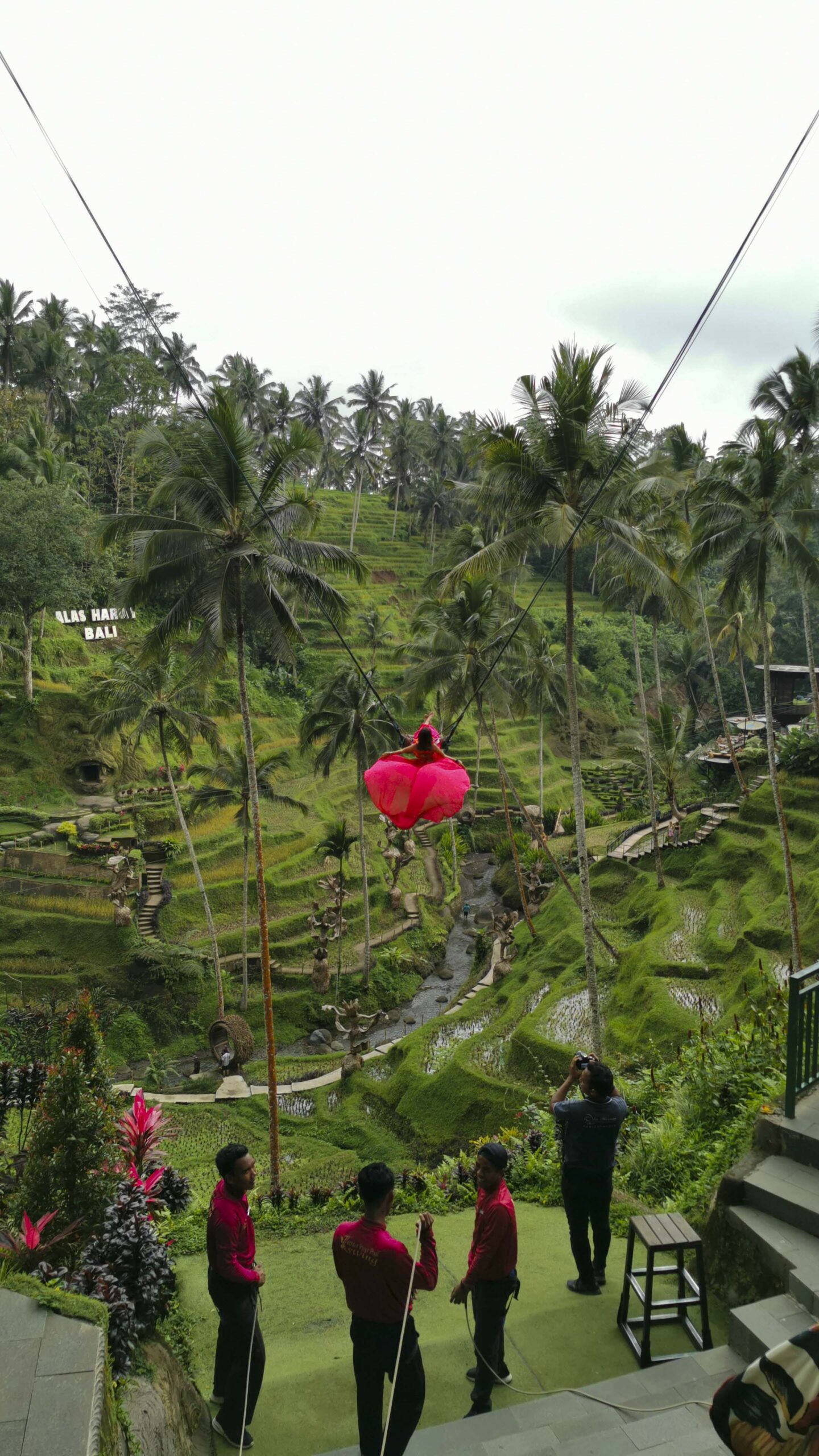
The main attraction of Alas Harum is the giant swing that lets you soar over a valley of lush vegetation. This is a great alternative to the original Bali Swing, as it offers a similar experience at a much lower cost. The swing is designed to give you a rush of adrenaline, as well as a sweeping view of the surroundings. You can customize your swing adventure by choosing from different heights and speeds, depending on what suits your preference and courage. While we refrained from getting onto the swing, we certainly enjoyed observing the skillful coordination of the swing pushers, who managed to synchronize their movements to boost the velocity of the ride. They seemed to have a knack for finding the right moment to apply force and create a smooth and exhilarating experience for the swing riders. It was almost like watching a dance of physics and fun. The price of the swing starts from 175k IDR. Girls can also choose from a variety of dresses to rent at an additional fee if they want to capture the perfect photo of themselves in a flowing gown while they swing.
Besides the swing, there are other things to do at Alas Harum, such as flying fox (zipline), sky bike, and bird nest. These are also designed to give you a sense of adventure and fun, as well as some photo opportunities. There are various photo booths and picture-worthy backgrounds that you can use to pose and take selfies. Some of them are quite creative such as the giant gorilla face carved on a hill, the hanging bridge, and the giant hand.
Another attraction of Alas Harum is the coffee plantation tour, where you can learn about the famous kopi luwak coffee. This is a type of coffee that is made from beans that have been eaten and digested by civets, a cat-like animal. The process is supposed to enhance the flavor and aroma of the coffee, making it one of the most expensive and sought-after coffees in the world. You can sample different kinds of coffee and tea at Alas Harum, including kopi luwak, for a small fee.
To be honest, we are not big fans of such cliche touristy spots that are crowded and overpriced. We prefer to explore more authentic and off-the-beaten-path places that reflect the true culture and beauty of Bali. However, we decided to give Alas Harum a try since our driver was so enthusiastic about it. We also thought it might be fun to try something different and adventurous for a change.
We ended up spending about two hours at Alas Harum, mostly taking pictures. We have to admit that they were quite fun and exciting, even though we were a bit scared at first.
We did not try the swing or the bird nest, as they did not appeal to us much. We also skipped the coffee tasting, as we are not coffee drinkers. We also felt a bit uneasy about the kopi luwak coffee, as we heard that some civets are kept in cages and force-fed coffee beans for this purpose and we did not want to support that.
The ticket price for Alas Harum was 200k IDR (about 14 USD) per person, which included access to all activities and attractions except for the coffee tasting. The coffee tasting is an additional 50k IDR (about 3.5 USD) per person.
Overall, our experience at Alas Harum was mixed. We had some fun and memorable moments, but we also felt that it was too touristy and commercialized for our taste. We think that there are better ways to enjoy Bali than swinging over a valley or posing with props. We would rather spend more time on the beach, in the temple, or in the village, where we can experience the real charm and spirit of Bali.
By 1 PM, we had finally arrived at the highly anticipated Bubble Hotel for our stay. Be sure to check out our blog of how spending a stormy day in a bubble hotel made our experience truly memorable.
Candidasa: 1 night
Candidasa is a charming coastal village that offers views of the ocean, flourishing rice fields, and serene temples. You can enjoy the calmness and beauty of nature, while still having access to modern amenities and activities. Unlike the crowded and noisy tourist areas in the south of Bali, Candidasa has a laid-back feel that wowed us. You can unwind in one of the many cozy hotels, villas, or bungalows that offer exceptional views of the ocean and the mountains.
We decided to spend one night at Candidasa as it is a great base for exploring the nearby attractions, such as the Tirta Gangga water palace, the mysterious Goa Lawah bat cave, the authentic Tenganan traditional village, and the sacred Besakih temple. Whether you want to snorkel in the clear blue water, hike in the grassy hills, or learn about the Balinese culture and traditions, you will find something to suit your taste and budget in Candidasa.
Day 10: Tirta Gangaa
Tirta Gangaa
Tirta Gangaa is a water palace in Bali that dates back to the 18th century. It was built in 1946 by the king of Karangasem as a sacred place for worship and relaxation. Tirta Gangga means “water of the Ganges” in Sanskrit, referring to the sacred river in Hinduism.

It is famous for its beautiful gardens, fountains, pool mazes, and koi fish ponds that reflect the Balinese and Chinese architecture. The palace is surrounded by lush rice terraces and hills, offering a view of the countryside. You can walk around the palace grounds, admire the intricate details of the carvings and sculptures, or even take a dip in the holy water that is believed to have healing properties.

We were amazed by the huge koi fishpond that welcomed us as we stepped into the complex. The bright fish glided smoothly in the transparent water, creating a fascinating sight. We couldn’t help but want to join them, so we jumped on the puzzle-like steps that crossed the pond. We felt like frogs jumping from one lily pad to another, while the enormous koi fishes surrounded us with interest. We giggled with delight as we steadied ourselves on the wet stones, feeling the water spray on our feet. Glancing around, we spotted a variety of stone sculptures portraying mythical creatures that guarded the palace. They seemed to grin at us as if inviting us to their magical world.
Tirta Gangaa is a tranquil oasis, but you have to plan your visit wisely. We found out the hard way when we arrived in the late afternoon and it was swarming with tourists and locals. It was almost impossible to enjoy the soothing and gorgeous scenery and to snap some photos with so many people around. One of the most awesome sights is the stepping stones that lead to a lotus pond, but you have to queue for ages and rush when it’s your turn. We had to wait patiently until the crowd dispersed. We strongly advise that you get there early in the morning or late in the evening when the light is magical and there are fewer people.
The palace is open from 8 am to 5 pm and the entrance fee is 50,000 IDR per person.
Bangli/Sideman: 2 nights
If you are looking to experience the real charm of Bali, you should consider staying in Bangli or Sideman. These small villages are nestled in the lush green hills of central Bali, away from the crowded and noisy tourist spots.
We had a fabulous time in Bangli, a place that most tourists never see. We chose to stay there because we wanted to celebrate our 6th wedding anniversary by having a Balinese blessing ceremony and renewing our vows (you can read about the whole experience and ceremony in our upcoming blog). It was an unforgettable experience that filled our hearts with joy and gratitude and connected us deeply with each other and the local traditions. We also enjoyed the simple and quiet life of the village, where people were friendly and welcoming. We roamed in paddy fields, colorful temples, and rugged mountains. We felt like we discovered a hidden gem in Bali, away from the crowds and noise of the popular destinations. We loved every moment of our stay in Bangli, and we hope to return someday.
Day 11: Gates of Heaven, Lahangan Sweet & Besakih Temple
Gates of Heaven at Pura Lempuyang Luhur
The Gates of Heaven in Bali are a sight to behold. Rising tall with imposing pillars, they serve as a celestial passage, connecting the earth to the sky. Against a serene canvas of blue and white, these gates exude an idyllic aura. Yet, their true splendor unfolds beneath, where the shimmering water mirrors the gate, evoking a sense of boundless expanse. It’s a striking contrast between the solid and the liquid, the earthly and the heavenly.
However, appearances can be deceiving sometimes.

Pura Lempuyang Luhur as it is locally known, is a beautiful temple complex with an impressive view of Mount Agung, the highest volcano in Bali. The temple is one of the oldest and most sacred temples on the island. It is situated on the slopes of Mount Lempuyang, about 1.5 hours drive from Ubud. The Gates of Heaven are the first of seven temples that you can visit at the Lempuyang Temple complex. The other six temples located higher up on the mountain are connected by a steep staircase of about 1,700 steps and require a hike of about 2 hours to reach them all. Most people only visit the first temple, where the Gates of Heaven are located. The temples are dedicated to different aspects of Hinduism, such as wisdom, prosperity, and harmony.
To visit the Gates of Heaven, you need to pay an entrance fee of 55,000 IDR per person which also includes a sarong and a sash that you must wear before entering the temple. You can hire a guide to take you around the temple complex, or you can explore it on your own. The temple is open from 7 am to 5 pm every day.
If you want to witness a heavenly sight, you should plan to visit the Gates of Heaven early in the morning, when the blue sky and the bright sun create a superb contrast with the white gate. You might also be lucky enough to see the grand Mount Agung looming behind the gate, adding to the mystical atmosphere. But be warned: with the growing popularity of the temple among tourists, you might have to queue for a long time to get your perfect shot at the gate, even if you arrive early. Another option is to go later in the day when the crowds are smaller and the light is gentler.
The Gates of Heaven is where most people take their photos. It is a split gate, which means it has two symmetrical doors that lead to the inner courtyard of the temple. The gate is framed by ornate carvings and statues, and it overlooks a lush green valley. The gate symbolizes the entrance to heaven, and it is said that only those who are pure of heart can pass through it.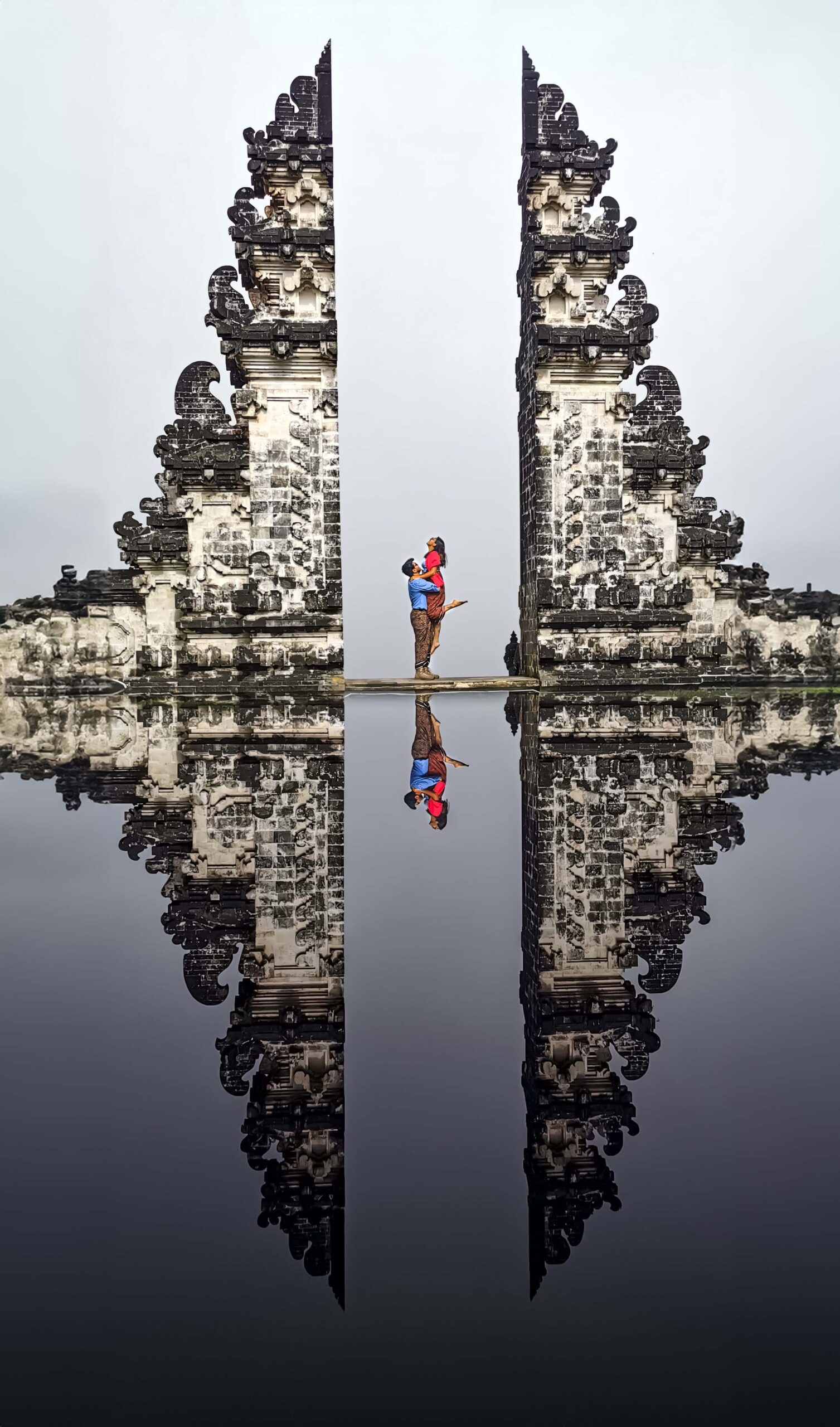
You can barely contain your thrill and curiosity as you approach the gates that showcase the temple’s splendor. You are about to immortalize this moment with a photo of the gates and their reflection. When it’s your turn, you give your camera or phone to one of the staff members who will snap your picture. But are you aware of the secret behind this reflection effect? It is not a pool of water that mirrors the gates, but a simple mirror placed under the camera lens by the temple staff. They employ this photography technique to produce an impression of a water surface that amplifies the photo. I had always envisioned a real waterbody at the base of the gates until my wife disclosed the truth to me. I felt let down but I have to concede, that this inventive trick always makes the photos look even more eye-catching. Once at the gate, you will have a few minutes to strike a pose and get as many shots as you desire. The staff members are very friendly and helpful, and they know how to get the best angles and effects.
The Gates of Heaven are worth visiting if you want to see one of the most beautiful and iconic sights in Bali. However, you should also be aware that it is not a secret spot, and that you will have to share it with many other tourists. You should also respect the local culture and religion, and dress appropriately when visiting the temple. If you follow these tips, you will have a great experience at the Gates of Heaven in Bali.
Lahangan Sweet Viewpoint
For those seeking a lesser-known spot to marvel at Bali’s enticing vistas, Lahangan Sweet is worth considering. This relatively new attraction provides a sweeping panorama of Mount Agung, Bali’s highest and most revered volcano, along with the dense landscape of the Karangasem region.
This hidden gem is located on a ridge, only 4 km away from the famous Pura Lempuyang temple and about 3 3-hour drive from Ubud or Canggu. You can easily get there by following Google Maps or the signs along the road. The road is mostly paved, but there are some steep and narrow sections. But be warned: the road can get tricky in some parts, especially after rain, so make sure you have a reliable driver or a good motorbike if you are driving on your own. We had planned to visit this spot early in the morning but just as we approached the location a few villagers warned us that the road was too slippery and risky for a car. They also said that the weather was not ideal for enjoying the scenery. To make matters worse, the sky was cloudy and gloomy, so we decided to skip it and head to Lempuyang temple instead. Luckily, by the time we finished exploring the temple, the sun came out and we asked our driver to take us back to Lahangan Sweet Viewpoint. He agreed, and this time the road was much better. We were so glad we didn’t give up on our plan because the view was worth it!
Upon reaching the parking area, a brief 10-minute walk along a uneven path leads you to the picturesque destination. Recent rainfall had left the path slick and muddy, yet our foresight in wearing sturdy footwear proved invaluable. Negotiating the rocky terrain cautiously, we skillfully skirted around puddles and mud patches. Before long, we arrived at the ticket counter, where we purchased our tickets priced at 30000 IDR each.
One of the most amazing viewpoints to visit in Lahangan Sweet is a unique wooden structure that wraps around a tall tree. It resembles a huge nest of a bird, and it offers an incredible opportunity to snap some photos with the Mount Agung in the background. If you are lucky enough to have a clear sky, you might even spot Mount Rinjani on the neighboring island of Lombok. We were not so fortunate, as some clouds were blocking the view of Mount Agung, but we still enjoyed the scenery and the refreshing wind. The nest can only accommodate up to 4 people at once, so you may have to queue up if there are many visitors. There is a small ladder that you can use to climb up the nest, and once you are there, you will feel like you are on top of the world. But be careful as the wooden platform is quite high and does not have any safety barricade.
If you want to spend more time at Lahangan Sweet Viewpoint, you can also book a camping spot on the mountain. There are several tents available for rent, or you can bring your own. There are also a few other platforms from where you can view the scenery.
Lahangan Sweet Viewpoint is open from 6 am to 6 pm every day. The best time to visit is either early in the morning or late in the afternoon. Avoid visiting during the rainy season (December to February), as the view might be obscured by clouds or fog.
Besakih Mother Temple
After finishing our lunch, we started our journey towards the Besakih Mother Temple, the largest and holiest Hindu temple on the island. It is located on the slopes of Mount Agung, an active volcano that is revered as a sacred mountain by the Balinese people. The temple complex consists of more than 80 individual temples dedicated to different gods and ancestral spirits.
We had high hopes of witnessing the splendor of the sacred mountain and the ancient temple, but the weather had other plans. As we stepped out of the taxi, the sky opened up and unleashed a torrential downpour. We quickly put on our rain jackets, but they were no match for the relentless rain.
We scanned the area for a place to take cover, but before we could find one, we were surrounded by a group of local women. They were holding colorful sarongs, as well as some offerings like flowers, incense sticks, etc. They claimed that their sarongs were made of fine fabric and had unique designs that symbolized the temple. They asked for a hefty sum which seemed outrageous for a sarong. Even though we denied it a few times they insisted that we had to buy their sarongs to enter the temple, as it was a mark of reverence and decency. We felt obliged to buy them as we didn’t want to miss the opportunity to see the temple. After bargaining we paid them 50000 IDR for two sarongs. Little did we know that other stores were selling the same for a lesser price.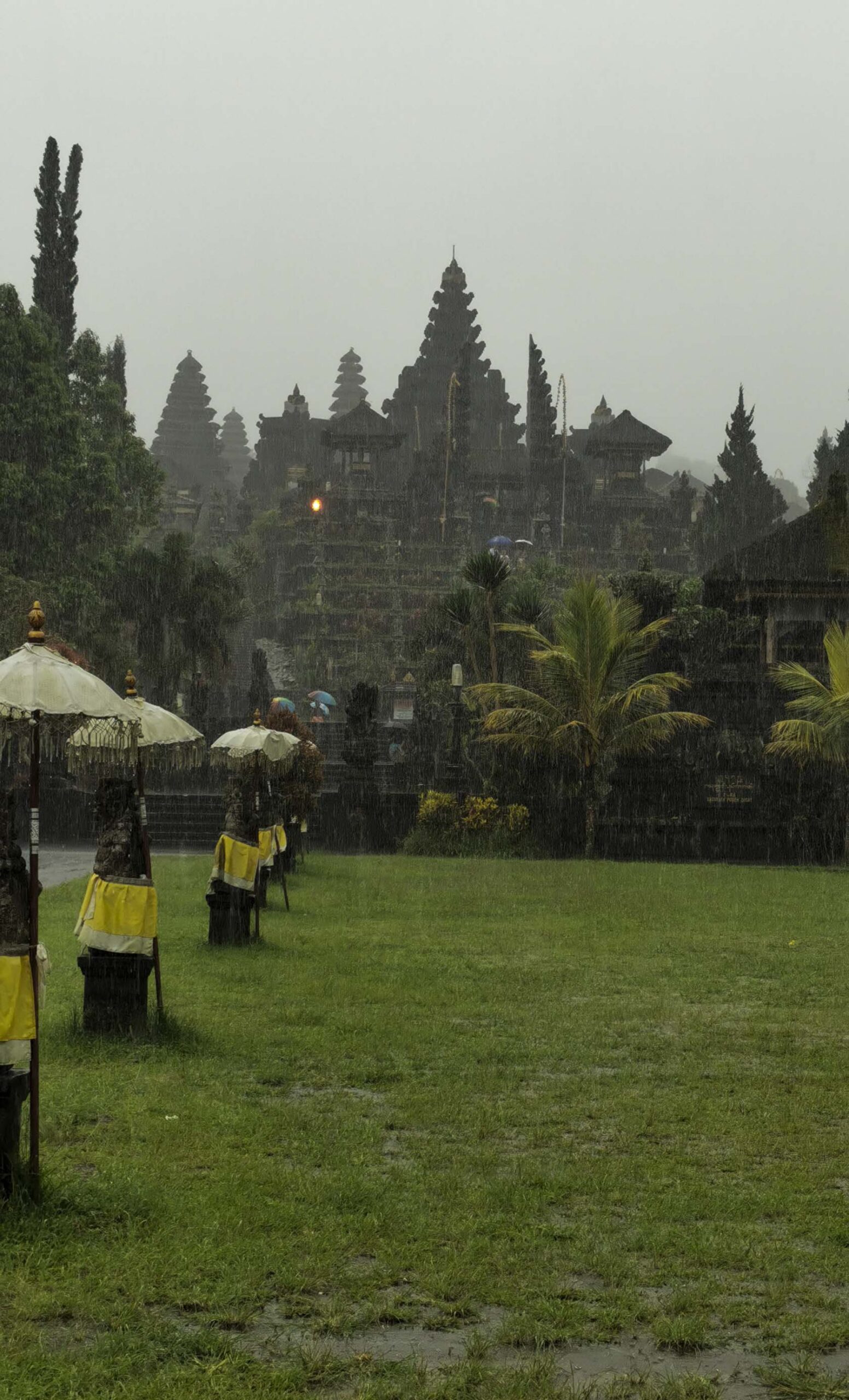
We wrapped ourselves in the sarongs and followed a guide who took us through the temple complex. He explained to us the history and significance of the temple, which dates back to the 8th century and is considered to be the mother of all temples in Bali. He also told us about the different ceremonies and festivals that take place there throughout the year. The temple was indeed big, with intricate carvings, statues, shrines, and pavilions. The rain was pouring down relentlessly, making it hard to appreciate the beauty of the place. We felt like we were in a foggy dream, soaked to the skin despite our jackets. But we also sensed the sacredness of the temple and the faith of the worshippers who brought their offerings and prayers to the gods. We decided to leave before we caught a cold.
Day 12: Tukad Cepung Waterfall & Balinese Blessing Ceremony
This was a special day for us. Ahead of our fifth wedding anniversary, we wanted to honor our bond with a Balinese vow renewal and blessing ceremony, a sacred and beautiful ritual. We only had one other thing on our agenda: a visit to a nearby waterfall that we had heard was picture worthy. It was only 4 km away from our cozy and eco-friendly Bali trade home, so we decided to hike there in the early morning, breathing the fresh and cool air. We followed the maps on our phones, chatting and laughing along the way, feeling excited and enjoying the serene atmosphere of the village. Within an hour we reached the waterfall.
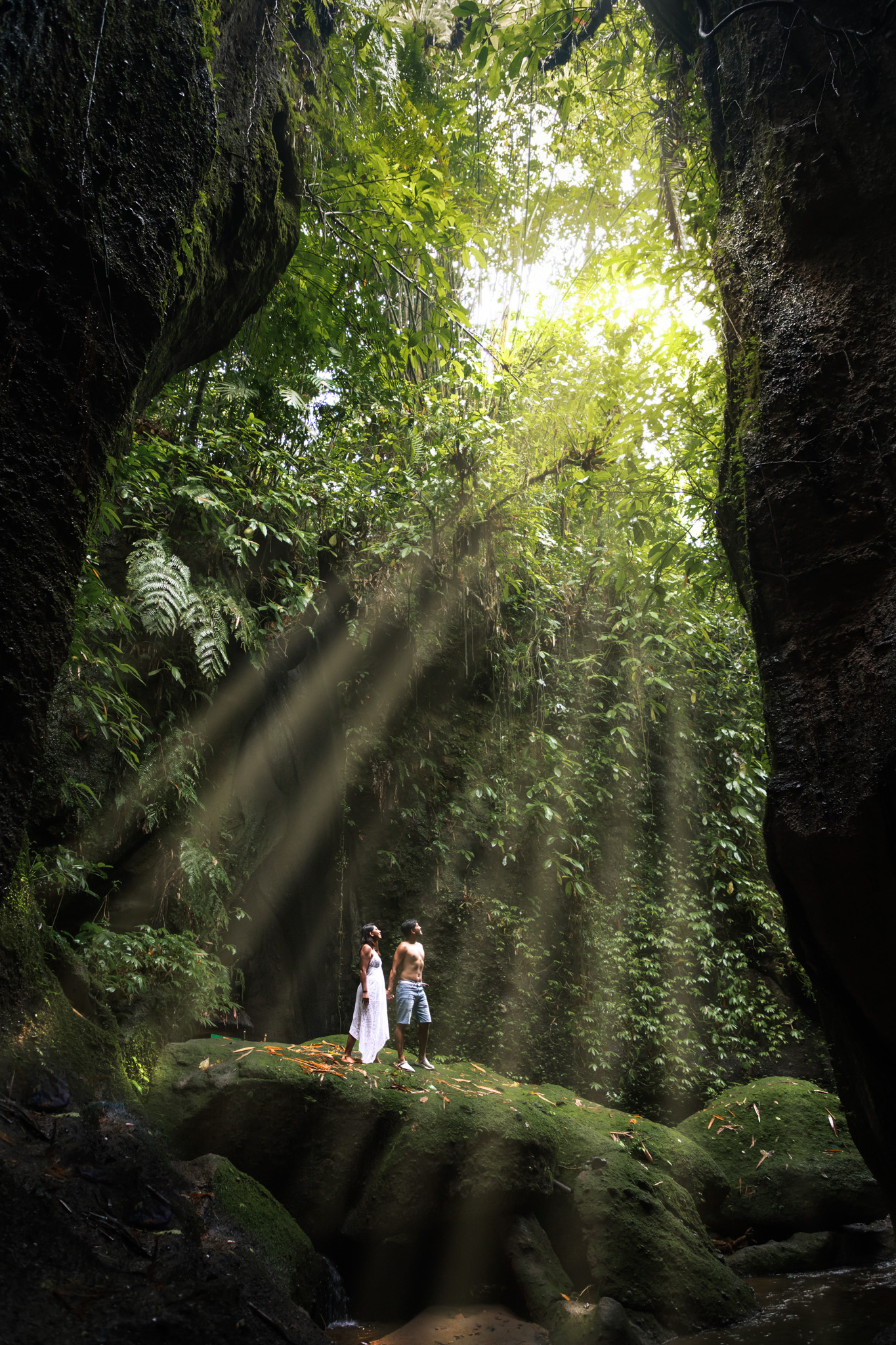
Tukad Cepung waterfall
Tukad Cepung Waterfall is located in Tembuku village, about 40 minutes drive from Ubud or 90 minutes from Kuta. This waterfall is tucked away in a cave, creating a magical scene that will take your breath away. You can easily visit it as a day trip from either of these places or combine it with other attractions in the area, such as Lempuyang Temple or Tegalalang Rice Terrace.
The entrance fee to Tukad Cepung Waterfall is 15,000 IDR (about $1) per person, and parking is free. You’ll have to walk for about 15 minutes from the parking lot to reach the waterfall, but it’s an easy hike. The only challenging part is the last section, where you have to go down some steep and giant stairs, and then wade through a small stream. Make sure you wear comfortable shoes or sandals that can get wet.
The reward for your effort is an amazing sight: a waterfall tumbling through a cave opening, lit by shafts of sunlight & and reached by a forest trail. The sun’s rays create natural beams across the canyon-like rock formations, making it look like a fairy tale. The best time to see this effect is in the morning, between 9 am and 11 am when the sun is at the right angle. However, this is also the most crowded time, so be prepared to wait in line for your turn to take photos. Luckily, we got there early enough to explore the whole area and enjoy the beauty.
The waterfall itself is not very big or powerful, but it’s still beautiful and refreshing. You can stand under the fine mist and feel the cool spray on your skin. The water is too shallow to swim in, but you can sit on the rocks and enjoy the view. There’s also another smaller waterfall nearby that you can check out if you want.
Tanha Lot: 1 night
Tanha Lot is a destination for anyone who loves nature, culture, and history. It’s not just about the famous temple on the rock, which is a sight to behold. It’s also about the amazing views of the ocean, the green rice fields, and the friendly Balinese people.
You can have all kinds of fun and adventure in Tanha Lot. You can hike the trails, watch the sunset, and enjoy shopping around the temple complex. You can also learn about the local legends and traditions from a guide. Or, you can just chill and enjoy the food, drinks, and spa services.
Day 13: Tanha Lot
It was a sunny day when we reached Tanha Lot around noon. We had booked a hotel within the tourist area, so we didn’t have to travel far to see the temple. Our driver advised us to get the temple tickets before we checked in, so we did that. The tickets were 60000 IDR for adults and 20000 IDR for kids, which goes towards keeping the site clean and beautiful.
We decided to wait until after lunch to go to the temple since it was too hot outside. We had a delicious meal at a nearby restaurant and then headed to the temple around 4 PM.
Pura Tanah Lot means “Land in the Sea” in Balinese. This holy Hindu shrine on a tiny rocky island in the Indian Ocean appears to float on the water when the tide is high. The temple is dedicated to the sea god Dewa Baruna. We learned that the temple was built in the 16th century by Dang Hyang Nirartha, a revered Hindu priest who traveled along the coast of Bali and felt the divine presence of the sea gods on this spot. He instructed the local fishermen to erect a temple on the rock, which became one of the seven sea temples that protect the island from evil forces.
As it was a low tide, we walked along the black volcanic sand beach and crossed a narrow pathway to reach the base of the temple. There, we saw a cave where a holy snake was said to guard the temple from intruders. Slowly the area near the main temple was getting overcrowded so we returned to the cliff terrace where we had a panoramic view of the temple and the ocean.

Tanah Lot is a spot to behold the most remarkable sunsets. Gloriya had already experienced that wonder before and we both were eager to relive it. Especially when the day was bright and sunny. We noticed all the photographers lining up to capture the glorious sunset. We positioned our cameras and waited for the sun to dip below the horizon. And we were truly fortunate. The sky was ablaze with orange, pink, and purple shades, creating a striking contrast with the dark outline of the temple and the ocean in front of us. We gazed as the sun gradually vanished behind the horizon, leaving behind a fiery glow. We felt like we had seen a magical spectacle, and we will always cherish our experience at the Tanah Lot Temple.
Shopping at Tanah Lot
We felt a surge of awe and gratitude as we stepped out of the temple gate. The shopping complex was buzzing with life and color, inviting us to explore its many treasures. We splurged on some gorgeous handbags that caught our eye, feeling happy and satisfied with our purchases. To end the day on a high note, we savored a delicious Balinese meal in a cozy and charming cafe, enjoying the flavors and the ambiance.
Bedugul: 2 nights
Bedugul is a beautiful area of Bali that offers many attractions and activities for visitors. One of the main reasons to stay in Bedugul is the pleasant weather, which is much cooler than the center of Bali. It is located in the highlands, surrounded by mountains, lakes, and forests. The average temperature is around 18°C, which is ideal for hiking, cycling, golfing or just relaxing. It also has a rich cultural heritage, with temples, markets, and festivals to explore. If you are looking for a refreshing escape from the heat and hurly-burly of Bali, Bedugul is an undeniable choice.
Day 14: Leke Leke waterfall & Ulun Danu Bretan
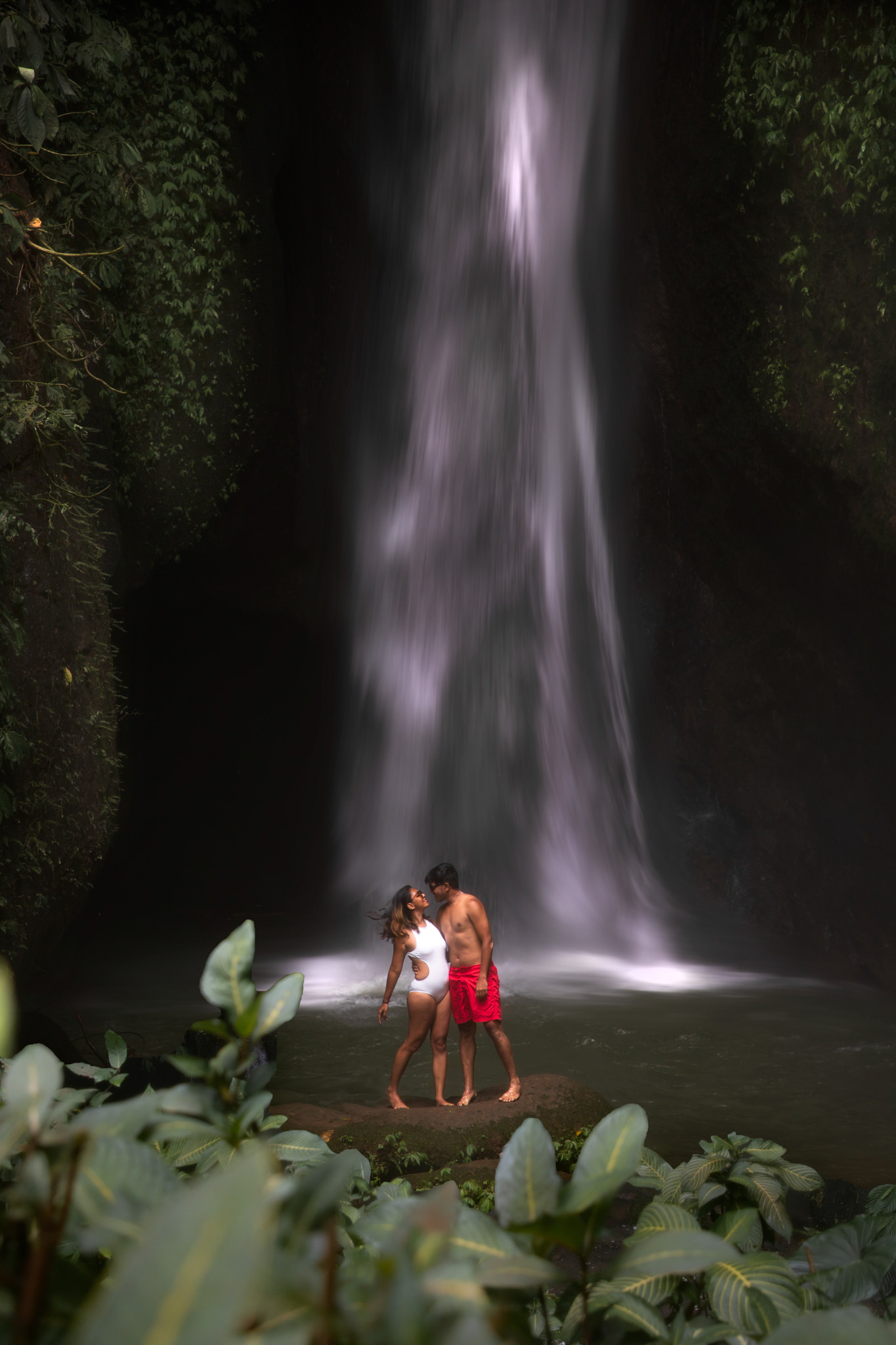
Leke Leke waterfalls
This waterfall hidden within the dense jungle of Tabanan Regency seems straight out of the land of fairy. It is approximately a 1.5-hour drive from either Canggu or Ubud. It’s one of the best waterfalls on the island. Leke Leke Waterfall, also known as Air Terjun Leke Leke, is about 15 meters tall and has a narrow stream of water that flows from the top of a mossy rock wall. At the base of the waterfall, there is a small cave and a shallow natural pool where you can swim and cool off. The waterfall is surrounded by greenery and creates a serene and refreshing ambiance.
To get to Leke Leke Waterfall, you’ll need to pay an entrance fee of 50,000 IDR per person at the ticket booth. From there, you’ll follow a well-marked trail that leads you through rice fields, bamboo forests, and wooden bridges. The hike takes about 15 to 20 minutes and is easy to moderate in difficulty. Along the way, you’ll see some beautiful views of the valley and the river.

Once you reach the waterfall, you’ll be amazed by its presence. You can take some lovely photos of the waterfall from different angles, or get closer to feel its spray on your face. If you’re feeling adventurous, you can climb up to the top of the waterfall and enjoy a different perspective.
Leke Leke Waterfall is one of the best places to visit in Bali if you love nature and waterfalls. It’s not as popular or crowded as some other waterfalls on the island, so you can have a more relaxing and authentic experience. It’s also a great spot to visit on a day trip from Canggu or Ubud, as there are many other attractions nearby, such as Handara Gate, Ulun Danu Beratan Temple, and Jatiluwih Rice Terraces.
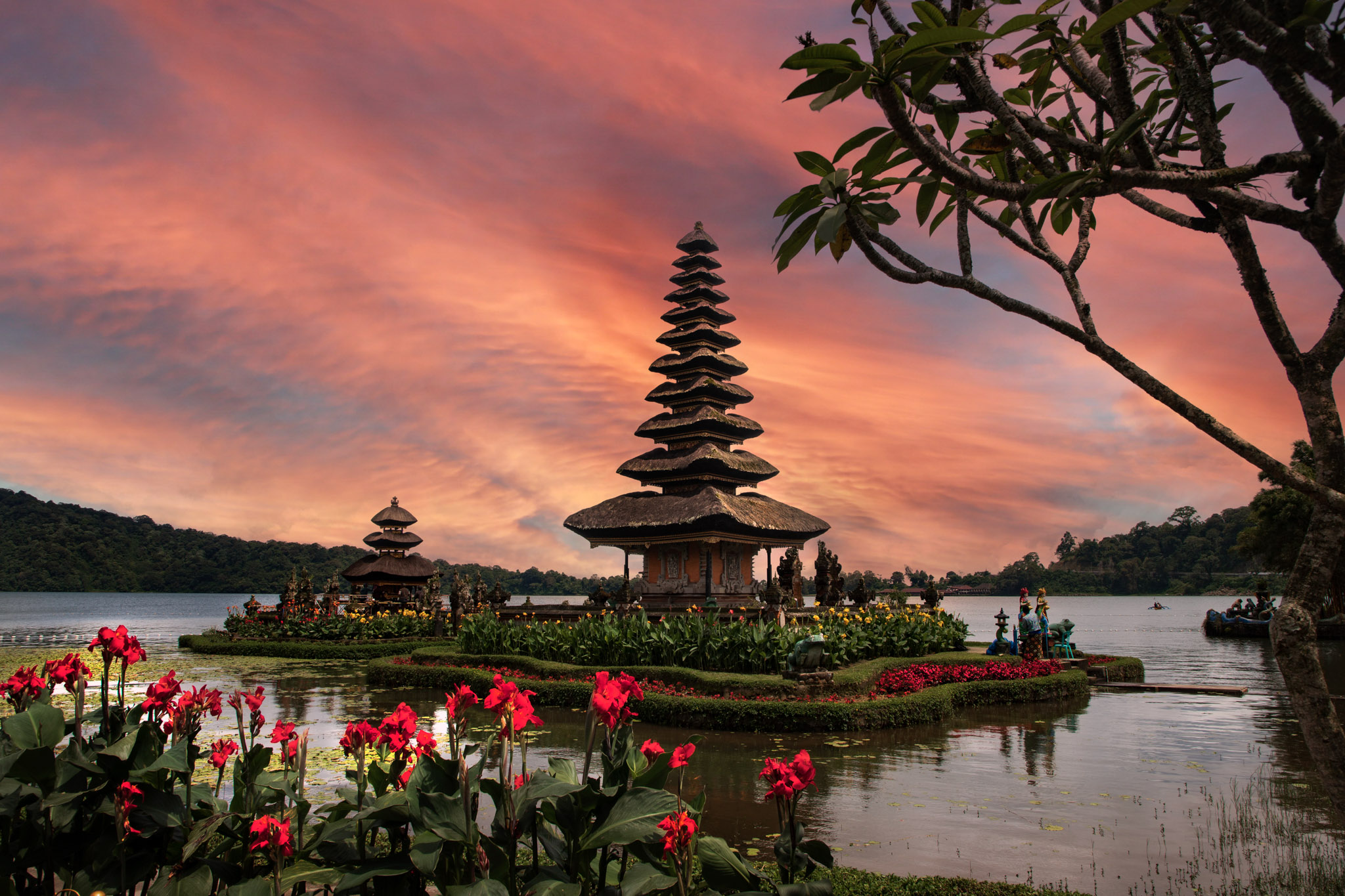
Pura Ulan Danu Bretan
One of the most attractive temples in Bali is the Pura Ulun Danu Bratan, located on the shores of Lake Bratan. The temple was built in the 17th century to honor Dewi Danu, the goddess of water, and to ensure the fertility of the land. The temple consists of several shrines with distinctive pagoda-like roofs that reflect the influence of Hinduism and Buddhism. The most epochal shrine is the 11-story Meru which stands on a small island in the middle of the lake and appears to float on the water when the lake level rises.
We visited the temple early in the morning, just as the sun was rising over the hills. The lake was like a giant mirror, reflecting the temple and the sky in perfect harmony. The air was crisp and refreshing, and we felt a sense of blessing as we explored the temple complex.
As the sun rose higher in the sky, the colors became more vivid and bright, creating a beautiful contrast with the surroundings. However, it also meant that more visitors started to arrive, making the place more crowded and noisier. We found it hard to walk around without bumping into someone or being asked to take a photo. We felt that we had enjoyed the place enough, and we decided to leave before it got too chaotic.
The temple opens for visitors from 7 am to 7 pm, and the entrance fee is 75,000 IDR per person. There are some activities that you can do around the lake, such as renting a boat, fishing, or taking photos with some animals like snakes and bats. There are also some souvenir shops and restaurants nearby.
Day 15: Explore Handara Gate and Resort

Handara Gate
While the Gates of Heaven in Lempuyang Temple are famous for their reflection shots, the Handara Gate at the entrance of Handara Golf Resort stands out for its captivating presence against the mountainous backdrop. Unlike most tourists who snap a quick picture and move on, we were drawn to stay at the resort after seeing the gate, and we were not disappointed. Despite being a mid-budget resort, the Handara Golf Resort’s location enchanted us for a two-night stay. One of the main reasons for our decision was the gate’s popularity, which meant it was often crowded with tourists. To beat the crowds, we planned to visit early in the morning. As guests, we also had the privilege of flying our drone over the gate, albeit for an extra charge.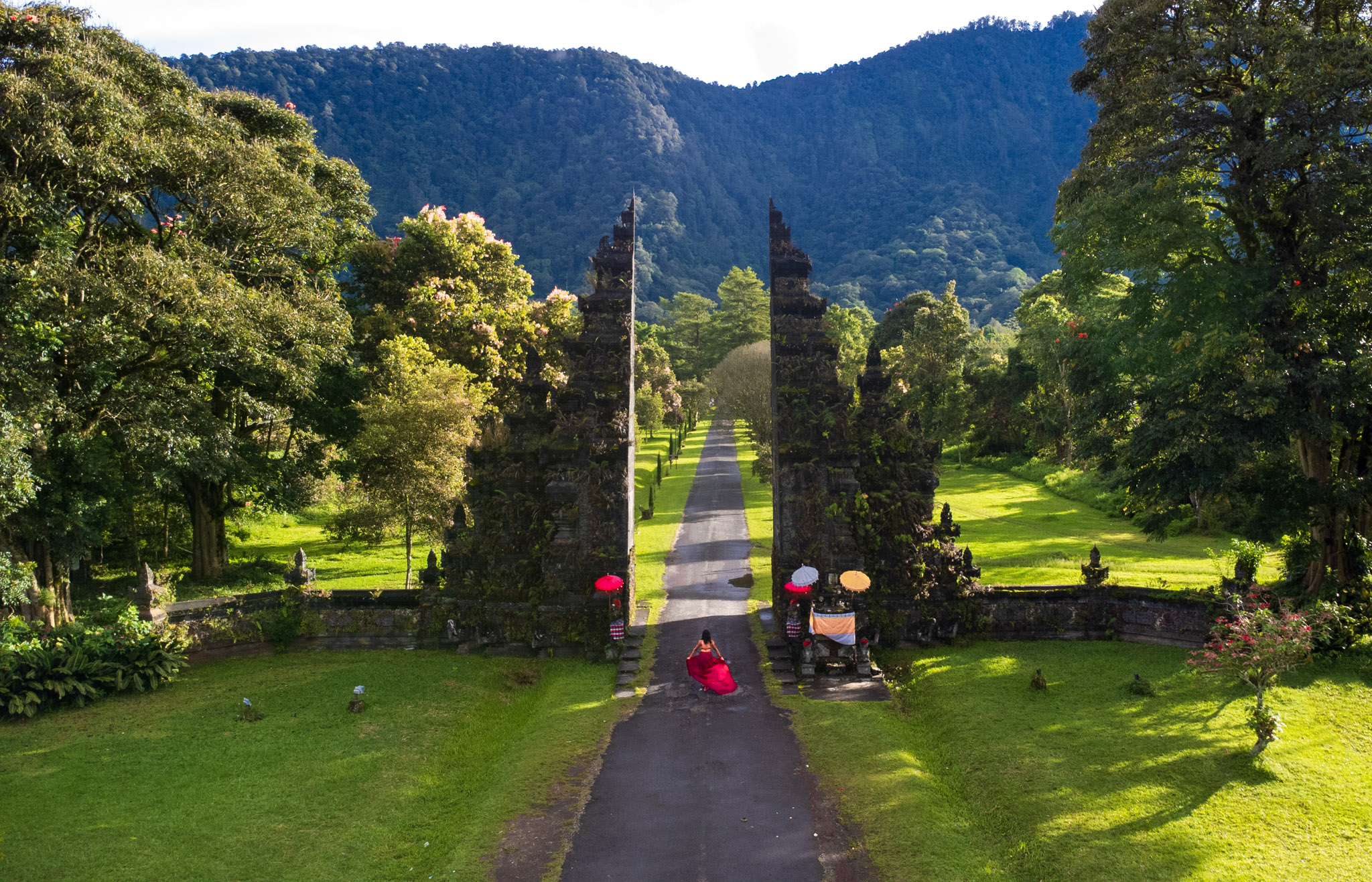
The gate is 2 km away from the main resort, so we rented two bikes very early in the morning and left our rooms. As we approached the gate, its weathered stone pillars loomed larger, draped in emerald moss. The gate’s imposing presence was heightened by the surrounding lush greenery, creating a scene straight out of a tropical paradise. The pathway leading from the gate seemed to stretch endlessly, disappearing into the mist-shrouded mountains. Each step revealed new vistas, each turning a postcard-perfect view. The gate seemed to open not only to the resort but also to a realm of peace and natural splendor.
For the following hours, we enjoyed exclusive access to the gate and its environs. We leisurely cycled around, capturing aerial footage of the gate with our drone, and even took a brief nap on the verdant grass.
The ticket for the Handara gate costs 30000 IDR but we got it complimentary from the resort. Drone tickets cost 100000 IDR.
Kuta/Denpasar: 1 night
From its humble origins as a fishing village, Kuta has blossomed into one of Bali’s most alluring destinations. A plethora of attractions awaits travelers in Kuta, from its expansive sandy beaches that stretch as far as the eye can see, to its lively bars and clubs that illuminate the night. The cultural tapestry of Kuta is equally delightful, shaped by the influences of Hinduism, Balinese traditions, and the myriad of international visitors who frequent its shores. Conveniently situated on the western coast of Bali, near the airport, Kuta beckons adventurers to explore its wonders with ease. It’s a place where the beauty, excitement, and cultural diversity of Bali converge seamlessly, offering an unforgettable experience to all who venture here.
Day 16: Seminyak Beach & Finns
Seminyak Beach
Nestled along the southwestern coast of Bali is renowned for its golden sands, clear blue waters, and breathtaking sunsets. Renowned for its swanky resorts, chic beach clubs, and vibrant atmosphere, the Beach offers a perfect blend of relaxation and excitement. Whether you’re basking in the sun, indulging in delectable cuisine at seaside restaurants, or experiencing the vibrant nightlife, Seminyak Beach promises an unforgettable escape in paradise.
Finns Beach Club
This is a place where you can enjoy the sun, the sand, the sea, and the music all in one spot. Finns Beach Club is located on the beautiful Berawa Beach, just a short drive from Seminyak and Canggu. It is a huge venue that can accommodate up to 10,000 people. What truly sets Finns apart is its diverse array of seating arrangements, catering to every whim and fancy. Whether you prefer sinking into plush bean bags, reclining on lavish poolside cabanas, partying with your group on lagoon beds, or indulging in the intimacy of a private rooftop lounge, the club ensures that your comfort and enjoyment take center stage.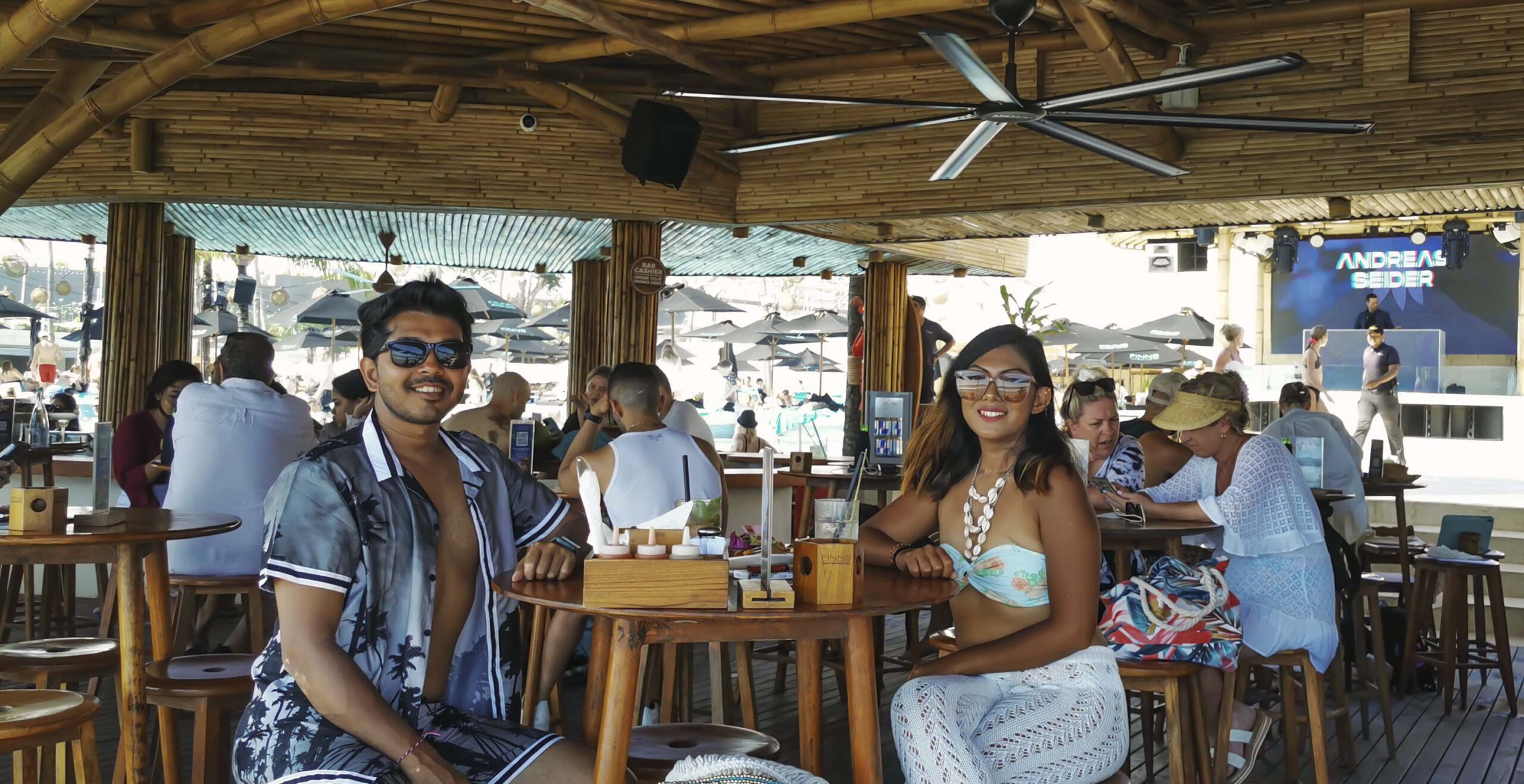
We spent one whole evening here, sitting on a beachside shack that gave us an uninterrupted view of the ocean and the sunset. At Finns Beach Club, the options for enjoyment are as boundless as the horizon itself. We immersed ourselves in the invigorating ambiance, taking refreshing dips in the crystalline pool, all the while savoring delectable cocktails from the swim-up bar and surrendering to the infectious beats spun by a live DJ. The music was a mix of house, techno, disco, and hip-hop, with different DJs playing.
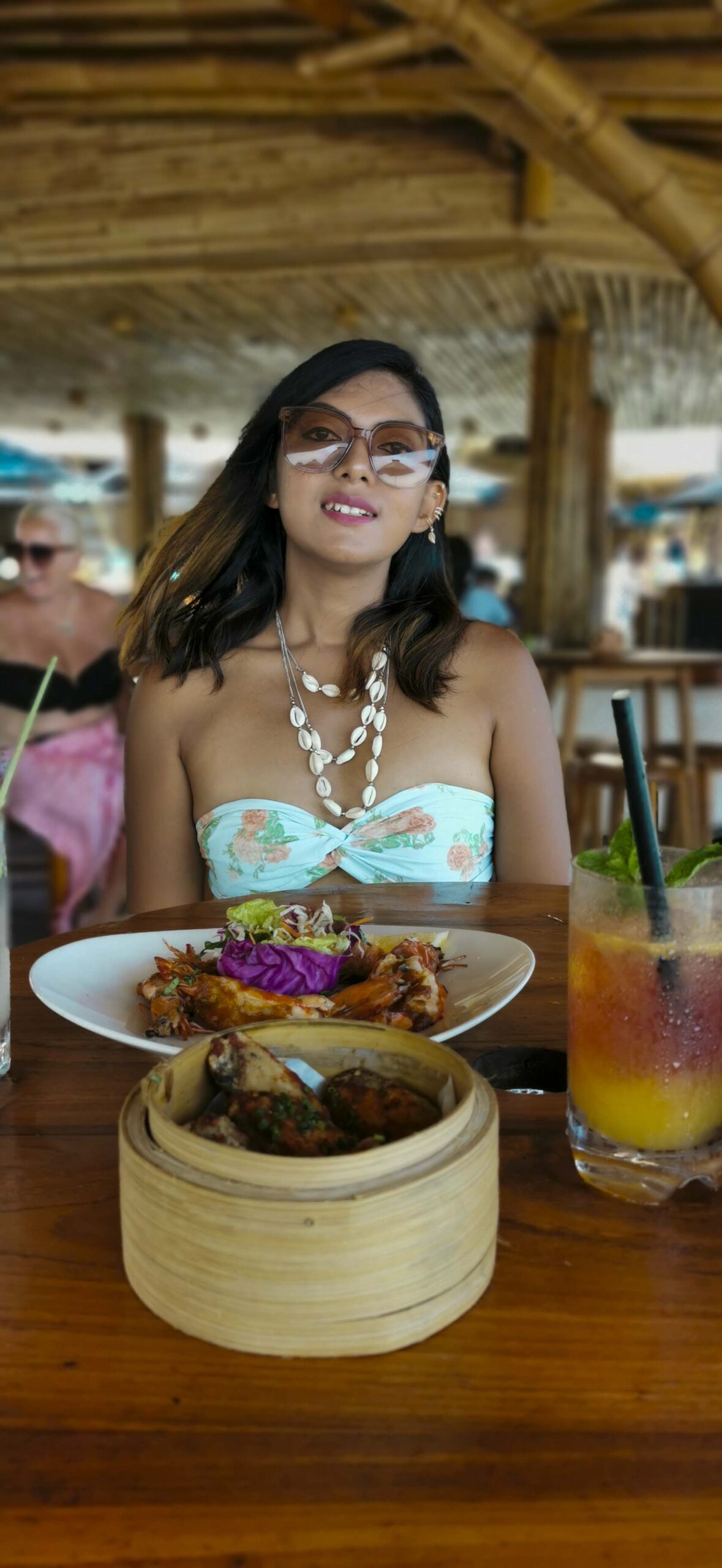
Finns Beach Club is more than just a beach club. It is also a lifestyle destination that offers many activities and facilities for guests. You can enjoy their spa, gym, tennis court, bowling alley, trampoline center, and kids club. They also have a VIP area that has its pool, bar, and lounge. You can book this area for private events or parties.
We had an amazing time at Finns Beach Club and we highly recommend it to anyone who wants to have some fun in Bali. It is a place where you can relax, dance, eat, drink, and enjoy the beautiful scenery. Finns Beach Club is open every day from 9 am to 11 pm. You can book your tickets online or buy them at the entrance. The prices vary depending on the season and the seating option you choose. You can also get a membership card that gives you discounts and benefits.
Day 17: Return to Home
As we bade farewell to the dreamy island of Bali, our hearts were heavy with both nostalgia and a tinge of sadness, we couldn’t help but reflect on the whirlwind of experiences that defined our two-week journey.
Our adventure began with wide-eyed wonder as we explored the sacred temple of Uluwatu. From the sun-swept shores of Nusa Penida Beaches to the lush rice terraces of Ubud, each day unfolded like a chapter in a dream.
But it wasn’t just the idyllic landscapes that left an indelible mark on our souls; it was the people we encountered along the way. Whether it was the warm smiles of the locals as they welcomed us into their homes or the camaraderie forged with fellow travelers over shared meals and laughter, Bali became more than just a destination—it became a sanctuary of connection and belonging.
Yet, amidst the exhilaration of adventure lurked moments of bittersweet realization. As our departure drew near, we found ourselves grappling with the inevitable sadness of saying goodbye to a place that had become our home away from home. The thought of leaving behind the sun-kissed beaches and the carefree spirit of Bali filled us with a sense of longing.
But all good things must come to an end, and after two weeks of paradise, we had to pack our bags and head back home. As we boarded the plane, bound for distant shores, we felt a mix of emotions: gratitude for the amazing memories we made, sadness for leaving behind such a ll place, and excitement for seeing our family and friends again. And so, as the sun dipped below the horizon, casting its golden glow upon the island we called home for a fleeting moment in time, we whispered a silent promise to return—to relive the magic, to chase the adventure, and to once again find solace in the embrace of Bali’s boundless beauty.
You May Also Like

Icy winter of Iceland: A complete guide on planning and surviving your next trip to one of the World’s most expensive country
May 6, 2019
Singapore: What makes this tiny nation one of the most visited destination on the planet?
September 22, 2019


